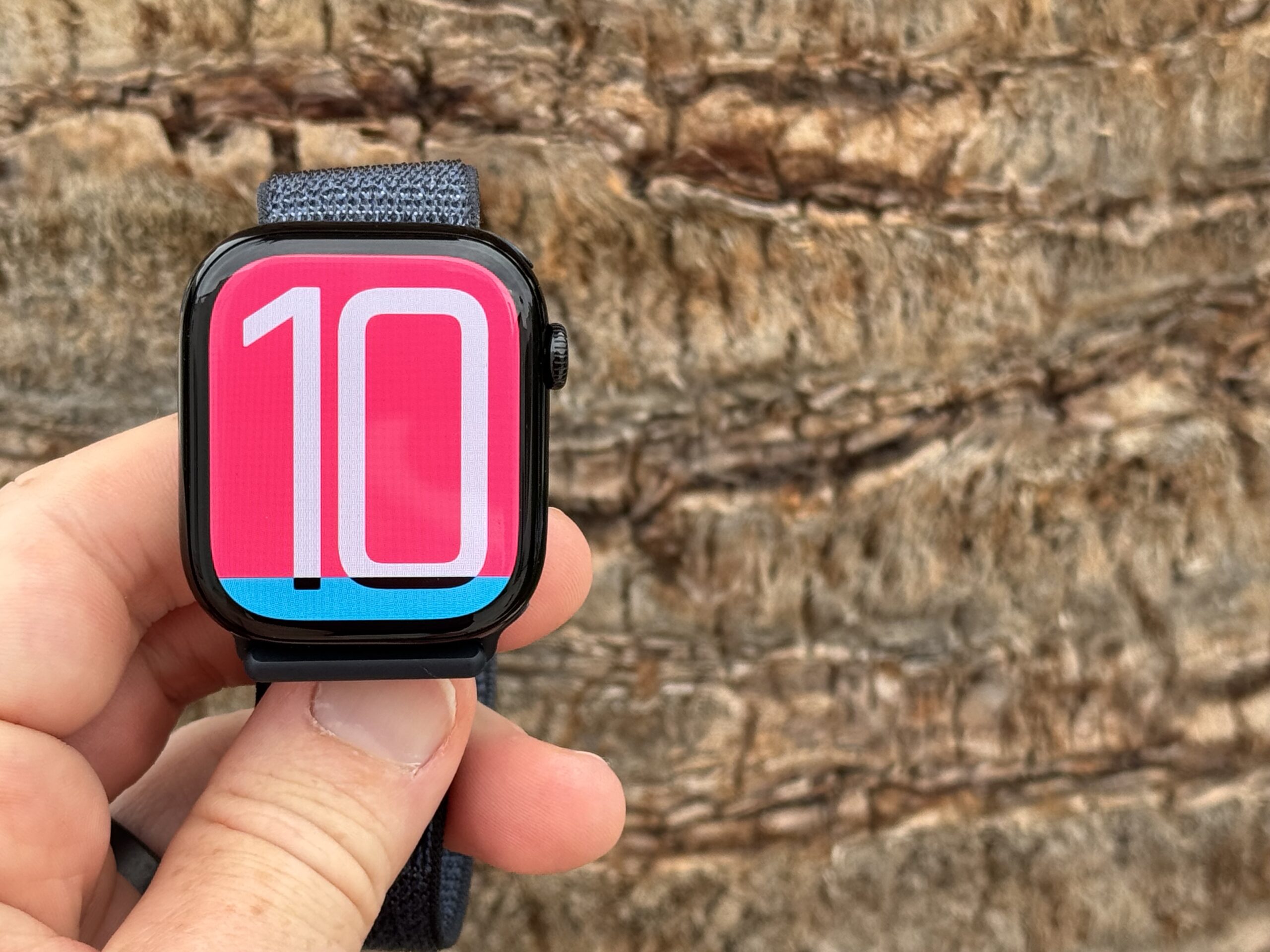The thing to understand about Apple Watch releases, is they aren’t targeting last years buyers. Nor even the year prior. Instead, they’re targeting previous Apple Watch owners 3-5 generations back. And true to that form, Apple each year just slightly increases the specs to make the upgrade path a bit more appealing. A bit more shiny. And a bit more brilliant.
Which, is exactly what the Series 10 does. There are no earth-shattering new features here for most consumers, well, unless you snorkel a lot. But under the covers it’s a substantial change in terms of the internals to fit into the thinnest Apple to date, with also the biggest screen to date. And you certainly notice that big screen when comparing it to even just the 45mm unit from last year. Instead, the majority of the new features come from the also new WatchOS 11, bringing in sports training load, overnight sleep metric trending, as well as a new Tides app and more.
I’ve been putting all these features to the test, both in the Apple Watch Series 10, as well as within watchOS 11, to see how well they work both day-to-day, as well as in sports applications. As usual, this watch is a media loaner, and it’ll go back to Apple. After which, I’ll go out and get my own for any future testing needs. If you found this review useful, you can use the links at the bottom, or consider becoming a DCR Supporter which makes the site ad-free, while also getting access to a behind the scenes video series And of course, it makes you awesome.
With that, let’s get into it!
(Note: The video review companion will show up shortly, I’ve been having some Final Cut Pro issues this morning, and at the moment, it’s likely my MacBook is gonna wish it had a depth gauge too, for when it gets tossed into the ocean…)
What’s New:
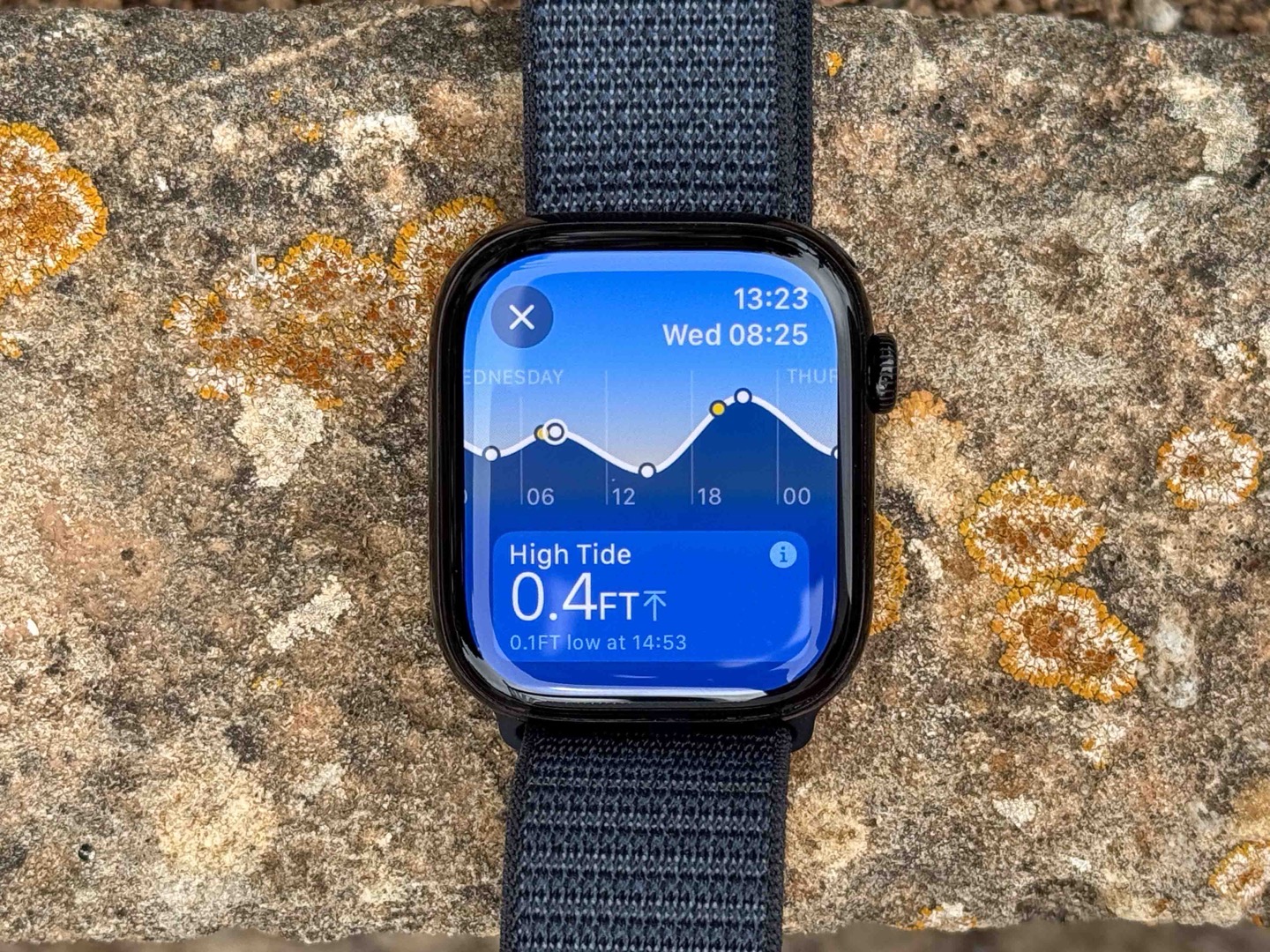
As is always the case with the Apple Watch releases, it’s really divided into two major camps: Things that are new on the watch itself (usually hardware) relative to the previous hardware version, and then things that are new due to the new WatchOS platform (which is announced months earlier in June). In this review, I’m aiming to cover both of those things, given I’ve spent all summer on WatchOS 11 since back in early June.
Starting on the Series 10-specific side first, here’s what’s new there:
– Totally new design internally, and new model sizes being introduced: 42mm/46mm
– Biggest usable display area to date in any Apple Watch: 374x446px for the 42mm 416x496px for the 46mm
– Thinnest design to date (9.7mm versus 10.7mm on Series 9)
– New ‘Ionic Glass’ screen design, which tapers further down the edge of the display
– New “Wide Angle OLED’ display, which is 40% brighter when viewed on an angle
– Always-on display mode will now show seconds even when wrist is down (updates at 1-second rate in standby mode, versus 1-minute rate)
– Added ability to have speaker play media/music (previously it wouldn’t, had to connect headphones)
– New faster charging times, 80% charge in 30 mins (fastest Apple Watch to date)
– New S10 sip (chipset) inside the Series 10
– Adds new voice calling automatic background removal with new neural network
– Adds depth gauge (supports depths to 6m/20ft for snorkeling – still maintains 50m waterproofing)
– Adds temperature sensor (supports water temperature for swimming activities)
– Adds new ’Tides’ app to show tidal data globally
– Adds snorkeling support for Series 10 (via 3rd party Oceanic App/partnership)
– Adds sleep apnea detection, monthly reporting with analysis reports
– Adds new sleep metric: breathing disturbances (which feeds into sleep apnea detection)
– Adds new ‘Flux’ watch face
– Adds new ‘Reflections’ watch face
– Adds new metal backplate to watch
– Three color options for base edition: Rose Gold, Silver Aluminum, Jet Black
– Three new polished titanium versions, weigh 20% less than existing stainless steel variants
– Titanium Series 10 is a carbon-neutral product
– Same pricing at $399 (42mm) & $429 (46mm), or $499/$529 for the cellular editions.
– Pricing for titanium is $699 for the 42mm, and $749 for 46mm (but includes cellular)
– Shipping on September 20th, 2024
Got all that? Good, now we get to layer in the WatchOS 11 features, which cover plenty of areas, but I’ll be mostly focusing on the sports/fitness/health ones. They are as follows:
– Added new workout Training Load features
– Added Vitals app (for trending overnight sleep metrics)
– Added custom routes for hiking/walking/running
– Added true offline maps to watch
– Added ability to pause Activity Rings
– Added ability to adjust goals on a per-day basis (e.g. Saturday)
– Added structured swim workouts
– Added distance and route maps to a pile of sport types
– Added safety check-in feature at start/end of work-out
– Added intelligent Smart Stack
– Added automatic offline language translations when you arrive in a country
– Added new watch faces/styles
And again, there’s a smattering of other very minor tweaks as well, but that’s the bulk of them.
Finally, note that there’s no change in the SpO2/blood oxygen sensor status. That remains as it has been since earlier this year, wherein Apple is unable to sell units with it enabled within the US. Existing users can keep the feature on their watch, as well as all non-US purchases. But units purchased in the US will not have that feature enabled. The hardware remains the same, so in the (seemingly unlikely) event something changes in a court case, it could be re-enabled. In fact, you’ll notice in WatchOS 11 on the Series 10, the user interface slot that was there in the ‘Vitals’ app for SpO2 is now removed.
Thus, let’s get onto using it.
The Basics:
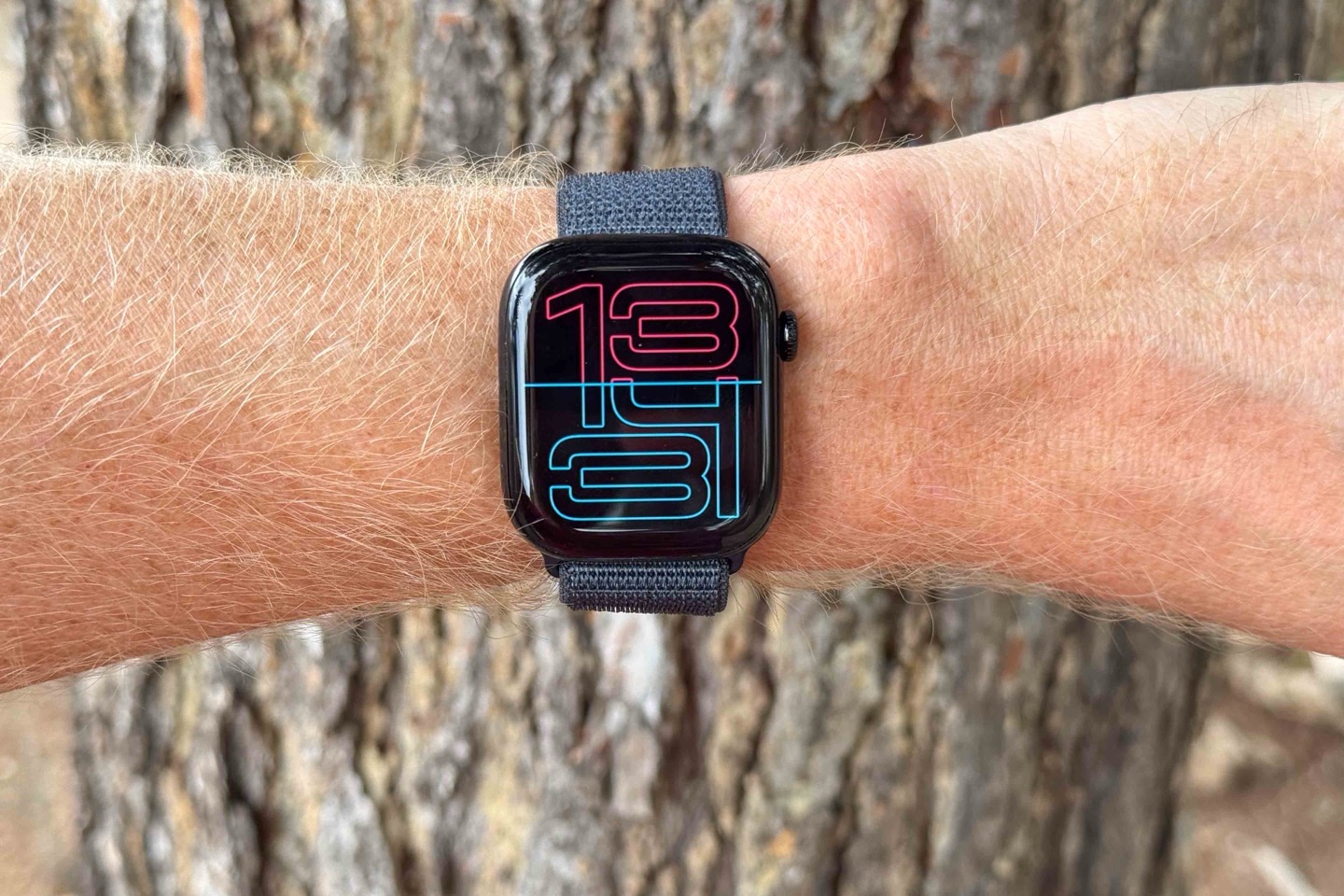
In this section I’m going to cover all the basics of the Apple Watch from a day-to-day standpoint, partially as a smartwatch, and partially covering some of the basic health/activity features. If you’re familiar with an Apple Watch from before, then very little of this realm has changed, save the new Vitals app.
Still, the most visible change is really just the front watch display itself, now being both larger, but covering the entire top of the watch, including slightly curving down the edges of the case.

How much you notice this extra bit of screen real estate will essentially depend on which watch you’re coming from. Unquestionably, compared to my Series 9 watch (45mm), it looks and feels quite a big bigger. More wider than anything else. That said, my wife wore it for a ride (and snorkeling) without any issues in terms of size, despite having a much smaller wrist (she’s 5’2”/157cm):
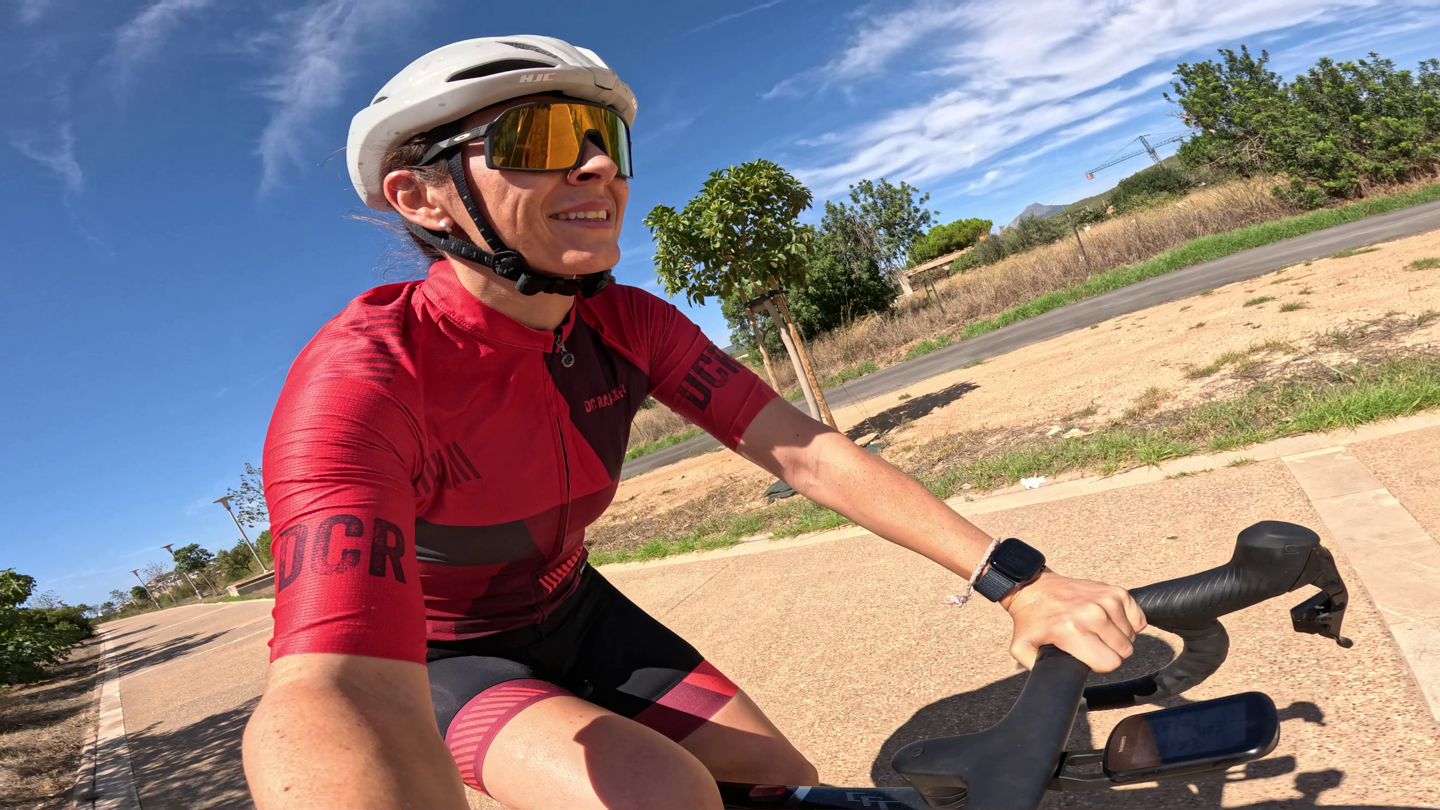
If you’re coming from an older watch, you’ll likely notice it even more. And ironically, as Apple noted in their keynote, this is actually an even bigger display area than the higher-end (and twice as expensive) Apple Watch Ultra 2. Not by a ton, just 3%, but the fact that it’s even the same size at all is notable.
Speaking of other hardware changes, while Apple did add their new S10 chipset to the Series 10, there’s no tangible user benefits except leveraging it for Apple’s voice isolation feature for voice calls. This feature will utilize just a single microphone on the watch, along with algorithms, to remove background noise in watch voice calls. Whereas something like the Ultra 2 series will leverage the 3 physical microphones instead (akin to what a GoPro does). The end resultant is essentially the same, just accomplished via two different methods.
In any event, back on the display/usability, the watch has 2.5 buttons on the side, as well as of course the touchscreen itself. The Digital Crown acts as both a button, as well as dial to scroll through menus.
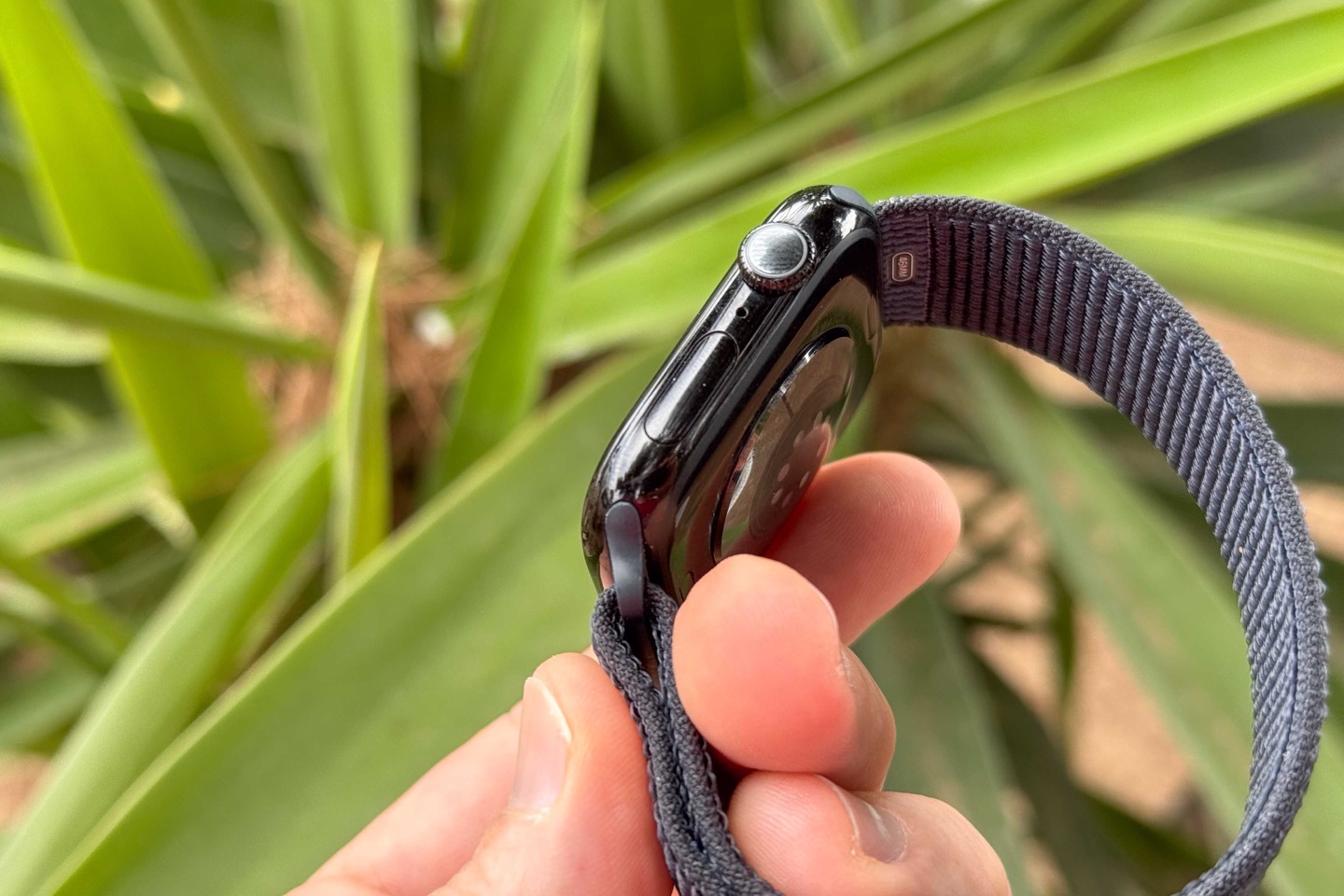
Apple introduced two new watch faces with Series 10, including this one shown below, that displays the second by ‘filling up’ like a cup of water. Which is notable as another new feature of the display, now showing seconds, even in a dimmed always-on configuration (previous units just updated once per minute in the dimmed state).
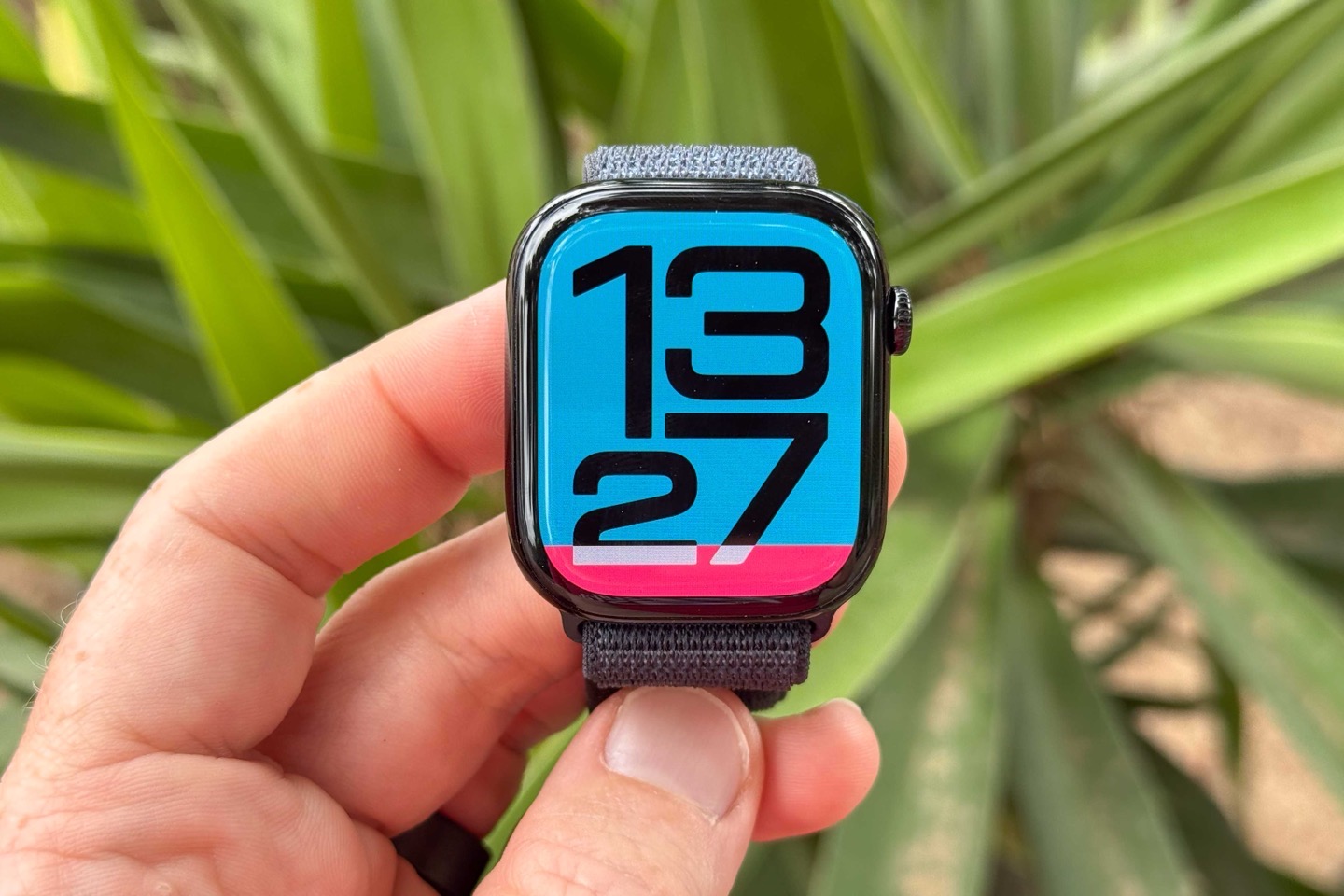
As with before, you can customize the watch face to any of Apple’s included ones, as well as customize the complications (data bits) on the watch face.
The display on the Apple Watch Series 10 is considered an ‘always on’ display by default, meaning that it’ll dim the display state when your wrist is down, but then increase brightness when you raise your wrist. The Series 10 has the same display brightness as the Series 9 (at 2,000 nits), but Apple has changed the technology in the display to make it brighter and more readable off-angle. And while that’s true, in real-life compared to a Series 9, it’s not all that noticeable. Instead, you’d notice it more comparing it against a much older Apple Watch.
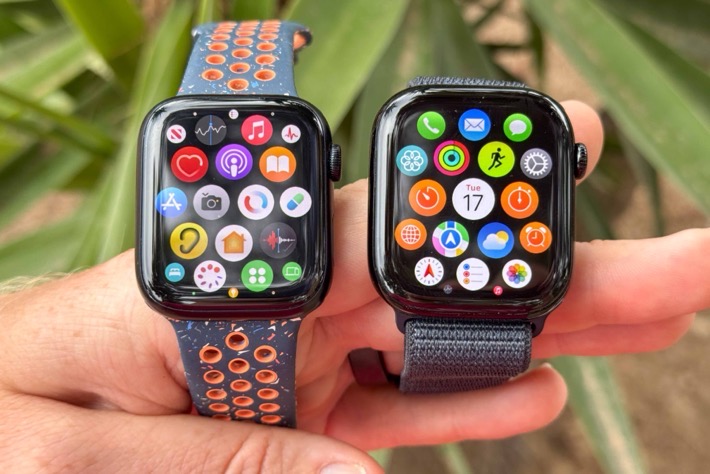
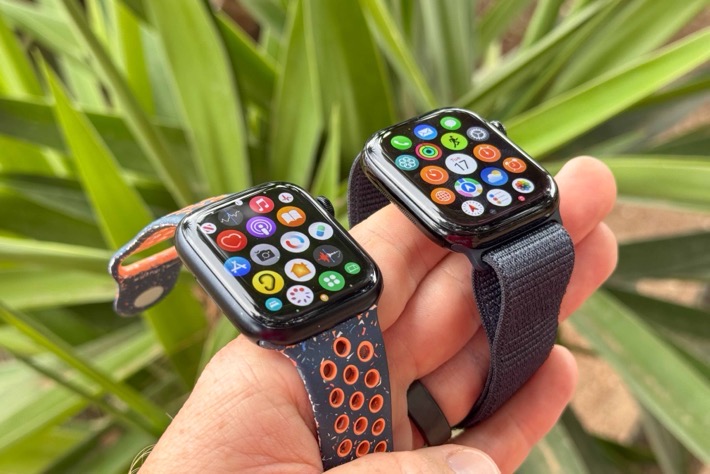
(Apple Watch Series 9 45mm at left, Apple Watch Series 10 46mm at right)
When it comes to daily activity tracking (e.g. steps), that’ll be seen within the ‘Activity’ app, along with its famed rings. These rings have different goals that fill up throughout the day. This includes the red ring for calories, the blue ring for stand time, and the green ring for exercise. By default this is standing at least once within each of 12 hours per day, 30 minutes of exercise, and 300 calories. In this context, the threshold/bar for what counts as exercise is pretty low, so even just walking briskly to the ice cream shop will get you credit.

All of this information is of course also visible on the Fitness app on your phone, letting you see the same data and looking at longer timeframes:
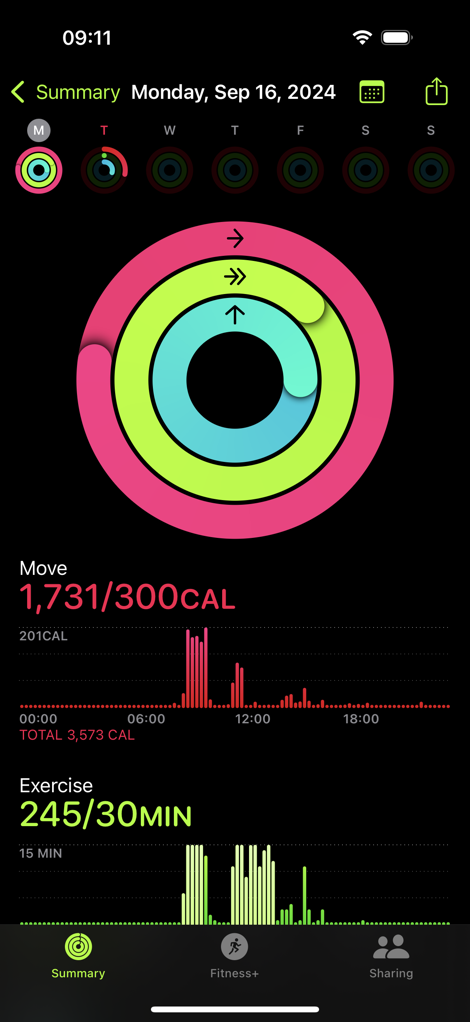
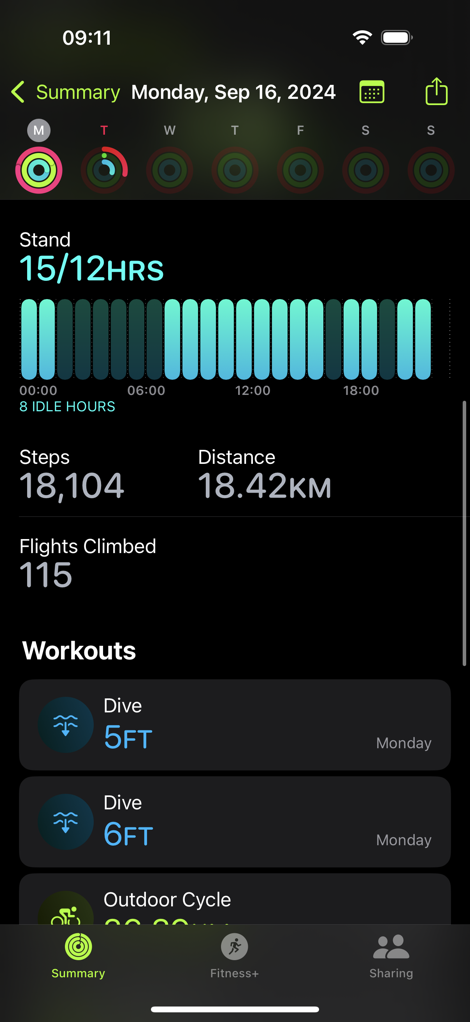
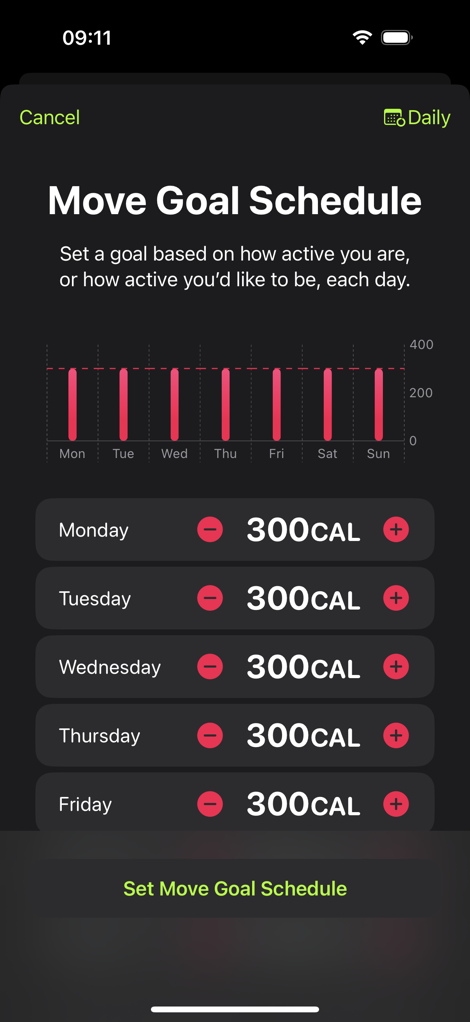
Within WatchOS11, Apple has introduced the ability to pause activity rings. This can be helpful if you’re traveling that day, or sick, or just have a crazy busy day at work. Likewise, you can now change the goals for each ring, by day. For example, let’s say you know each Monday is a non-starter for accomplishing your rings, you can change all Monday’s. Or equally, you can change it just for today (such as the day after you ran an ultra marathon).

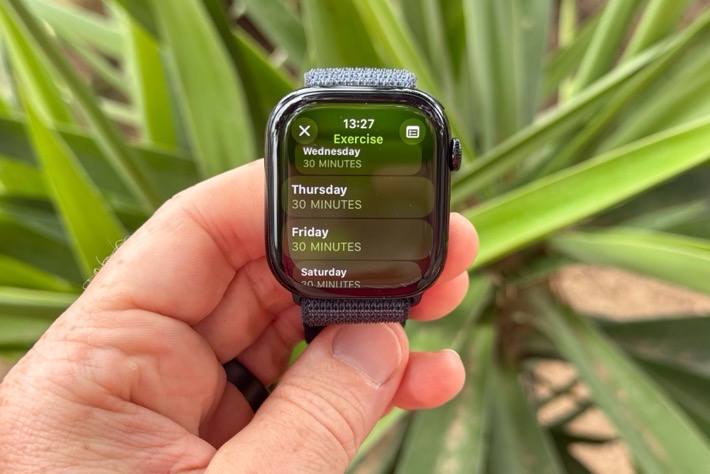
Speaking of things that make you want to sleep, there’s the sleep dashboard, where you can look at your sleep stats from last night as well as the 14 days. The first and second pages shows last night’s sleep data, including sleep phases/stages:

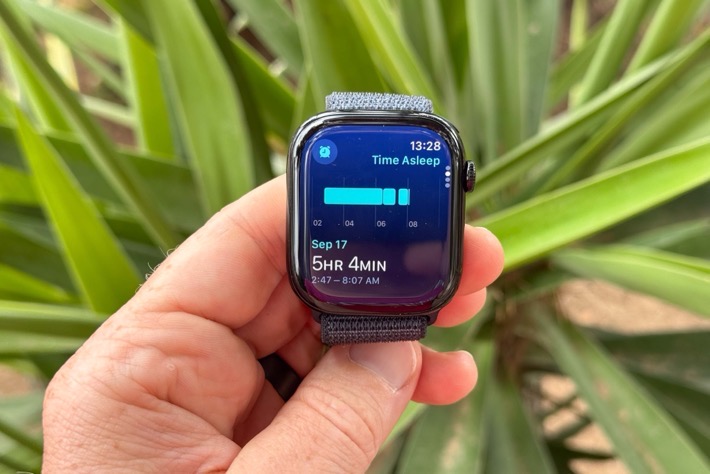
While the last page shows how the last 7 days compares to the previous 7 days:

From a sleep times standpoint, I had no issues with tracking accuracy for the times I fell asleep and woke up, in terms of accuracy of that data. However, as I note in every review, comparing the stage/phase data is basically like throwing spaghetti at a wall. Even the “most accurate” methods to compare sleep phases/stages is only in the mid-80% accuracy range, which, we’d never accept for comparing heart rate data to be wrong 20% of the time as our ‘gold standard’. Thus, I don’t do comparisons of sleep phases/stages, as catchy/fun as the might be.
Now, one area that’s new in the Series 10 is the tracking of sleep apnea. This received FDA approval on over the last few days, and Apple has rolled it out yesterday to Series 9, Series 10, & Ultra 2 watches. This feature is designed to determine whether sleep apnea exists over the course of a 30 day period, and then alert you, providing you with a report you can take to your doctor.
The new feature starts off with a new metric, “Breathing Disturbances”, which you’ll need to enable in order to start gathering the data. You’ll get prompted to enable it in a few different places while setting things up, but ultimately the enablement happens within the Apple Health app, taking just a few seconds:
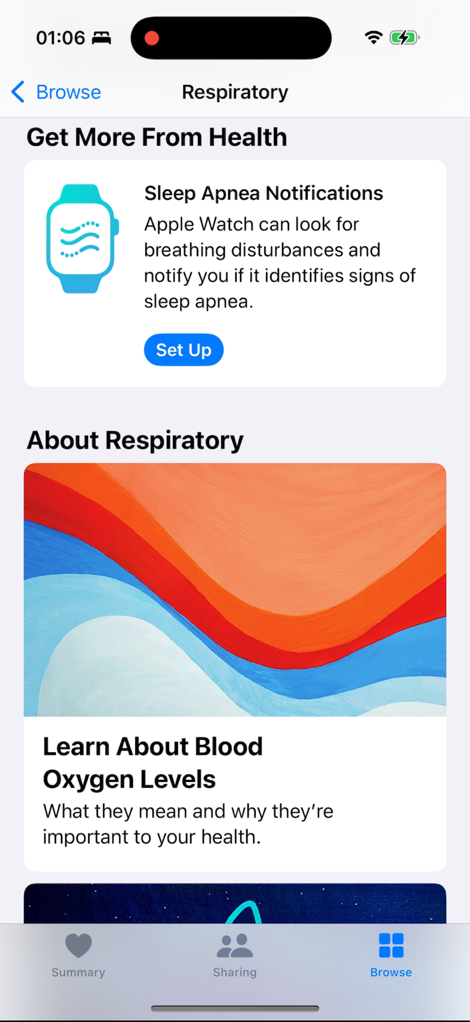
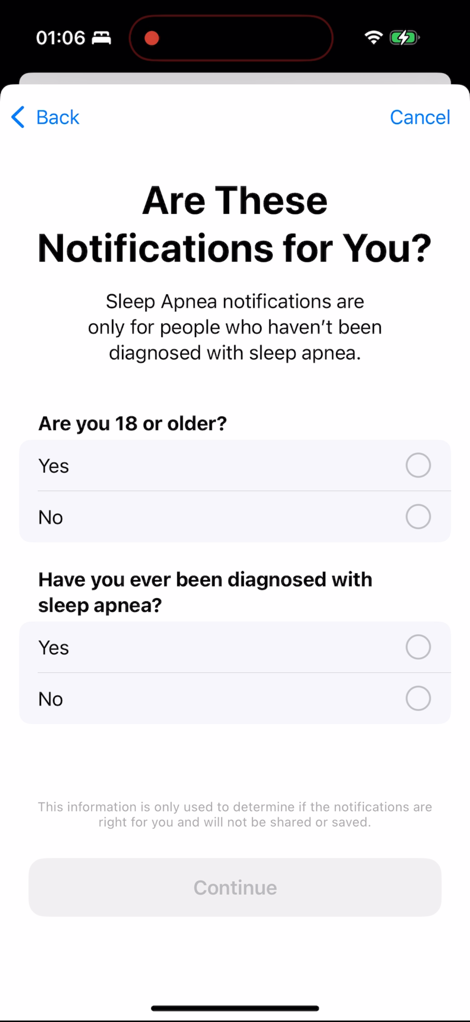
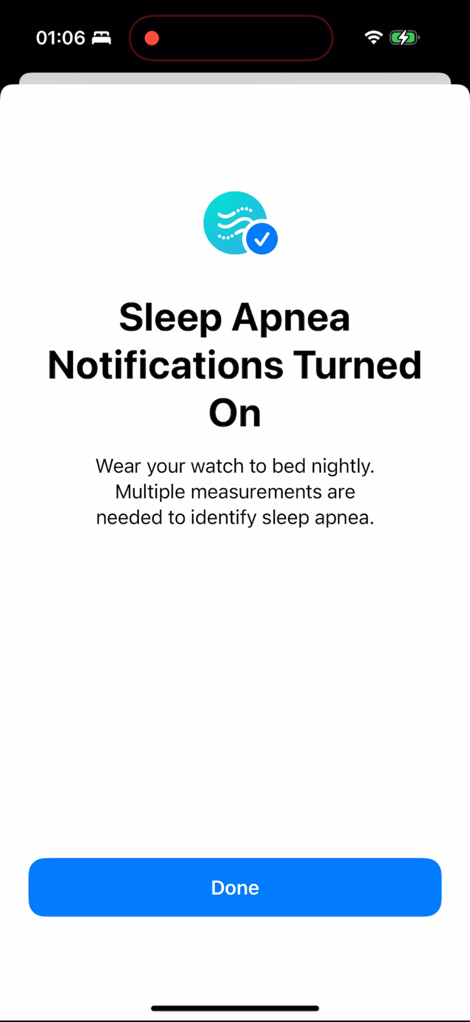
Immediately on your next night of sleep, you’ll start gathering data in that bucket, just like any other nightly metric. This will be categorized as Elevated or Non-Elevated, and you don’t need to wait the 30 days for the to occur. You can see this already happening on my unit despite just enabling this feature two nights ago:
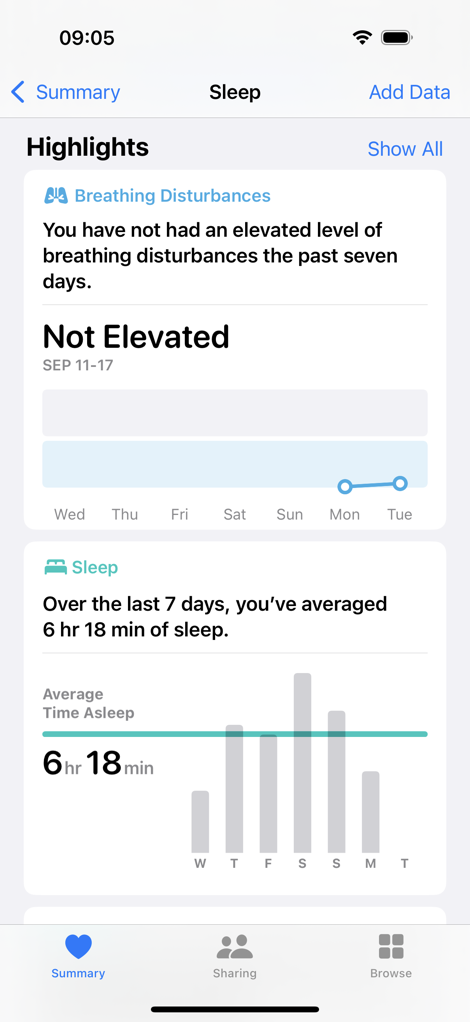

Note that some level of breathing disturbances are entirely normal and expected (and can be impacted by simple things like alcohol), however, when they cross into the ‘elevated’ range, they become a concern for sleep apnea
Each month, after the initial 30 days, the iPhone will analyze the data from your Apple Watch and generate a report if/when sleep apnea may have occurred. It’ll include details on what level that occurred, and is based on machine learning and data from a validated clinical study Apple did with 1,400 people including 30 nights of sleep and compared to a medical-grade APAP diagnostic device, cross-referenced by medical experts to validate the data. Apple says the full details of the study will be included in Apple’s FDA certification paperwork, which should be released shortly.
Technically speaking, the 30 day threshold requires 10 nights of sleep (with at least four hours per night), and within that 10 nights, 50% of those nights must have triggered an elevated reading, which in turn requires a ‘Moderate’ level of breathing disturbances. Once that happens, you’ll see an alert like this on your phone (this is a sample from Apple):
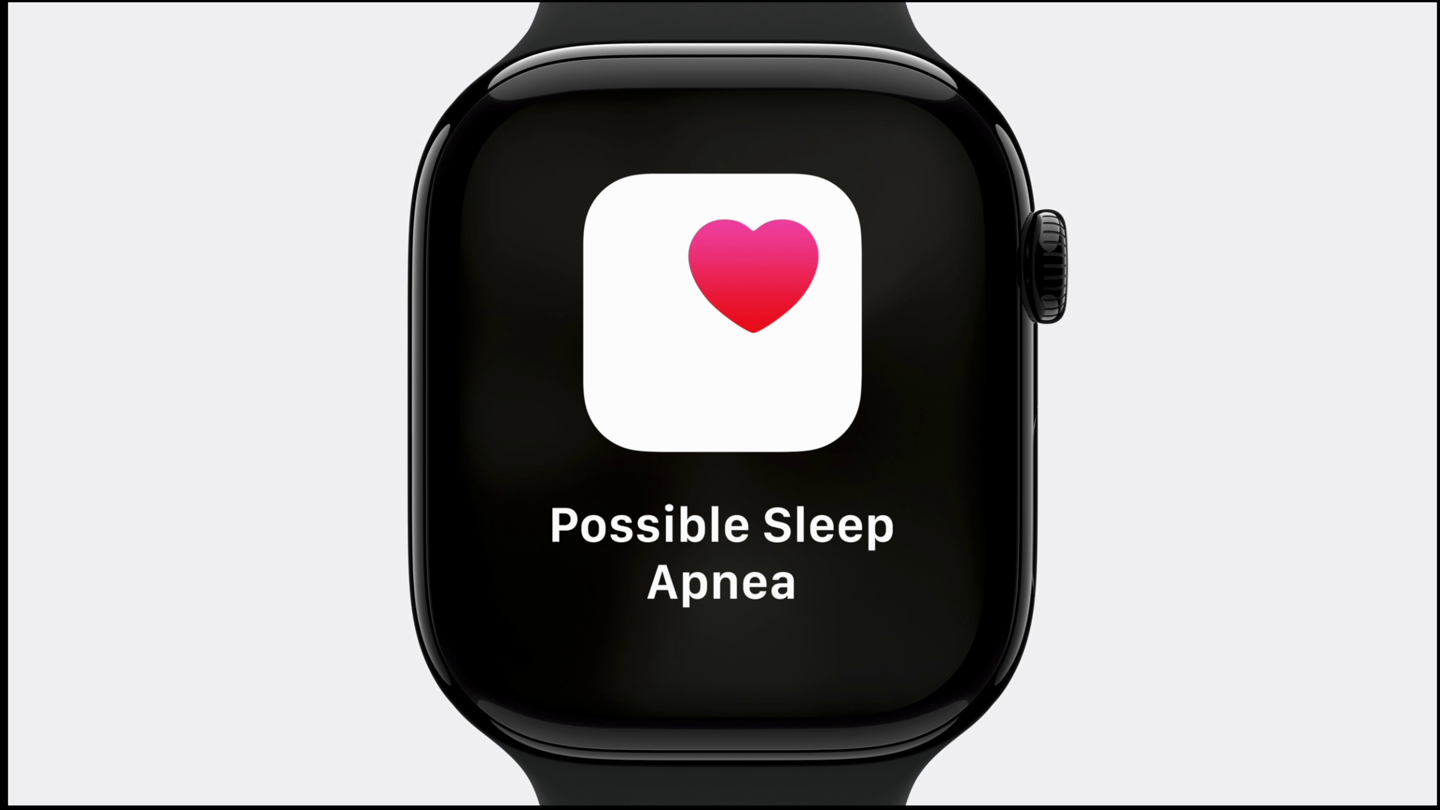
And then following that, you’ll see a page on your iPhone that gives you more information, including exporting out a PDF report of the data for your doctor.
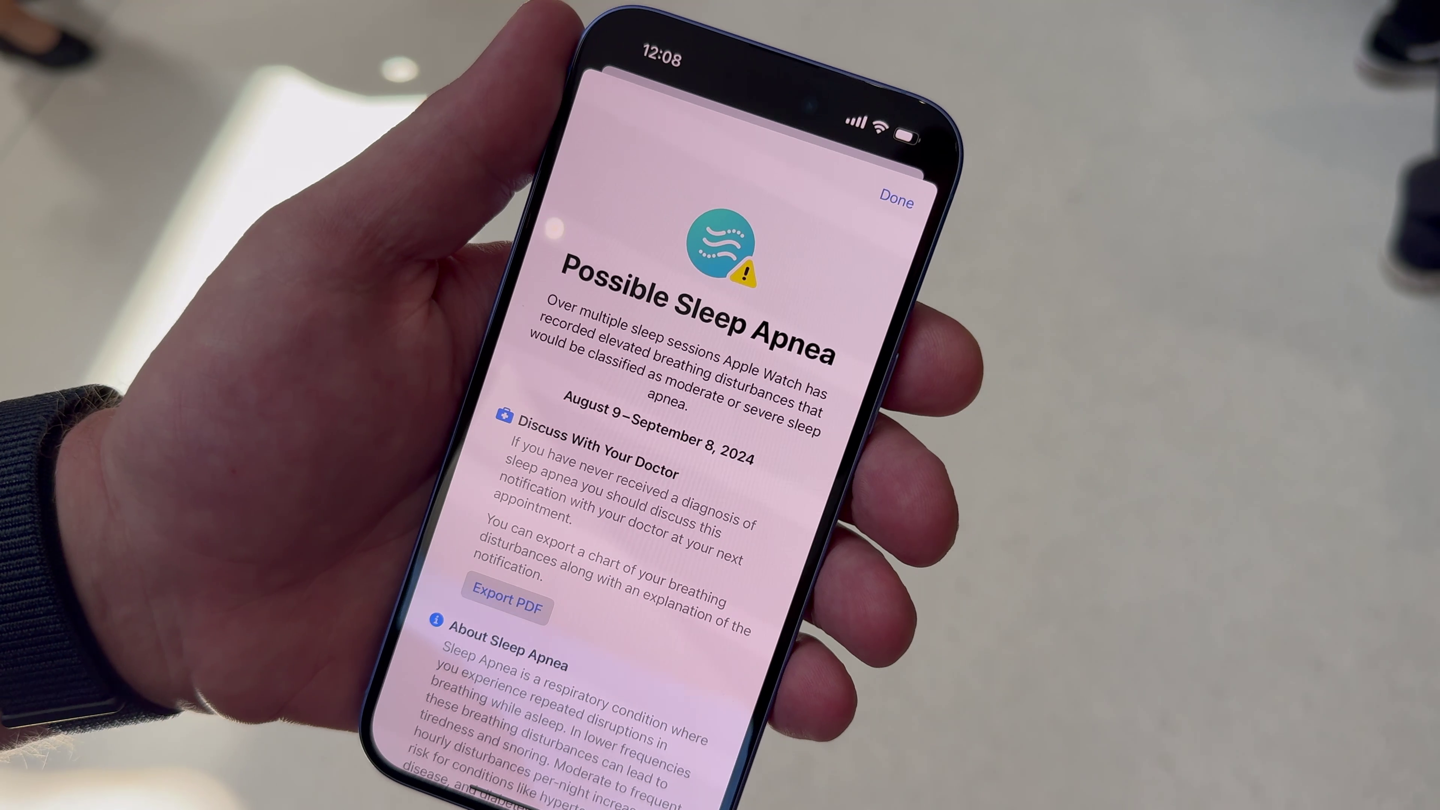
The next sleep related piece has nothing to do with sleep apnea, but is instead Apple’s new WatchOS11 trending of your nightly sleep related metrics. This is the new ‘Vitals’ app, which shows your nightly resting heart rate, overnight respiratory rate, overnight wrist temperature trending, and overnight sleep duration. For those who buy the Apple Watch outside the US, it’ll also include overnight SpO2 (blood oxygen) levels. This is a separate app on the Apple Watch, though on your phone, the data is rolled into the Health app. On the watch you’ll see this display:
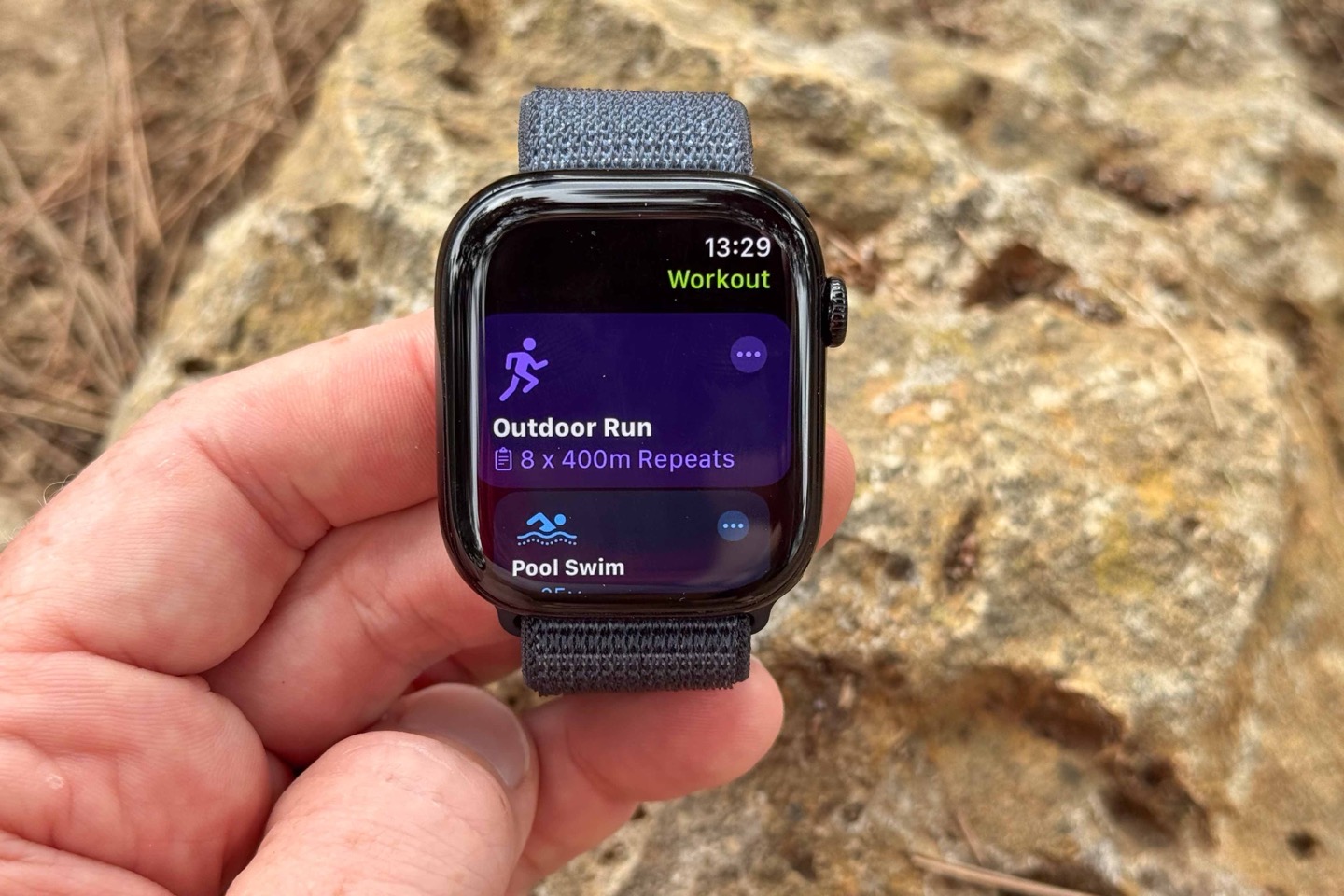
You can then scroll through each of the metrics individually to see their data.
The Vitals app will also outline any outliers, bubbling them up to you, to consider (or, ignore). I’ve yet to have any outliers occur over the last three months of WatchOS11. Nonetheless, in the examples above/below, you’ll see the ones in pink as being ‘outliers’. Whereas the ones in blue are within your normal range. If you get two outliers within this range, it’ll notify you, prompting you to look more closely at those metrics and possible causes (seen above, right). Also note below the inclusion of blood oxygen (2nd from right) levels, for those purchasing outside the US.
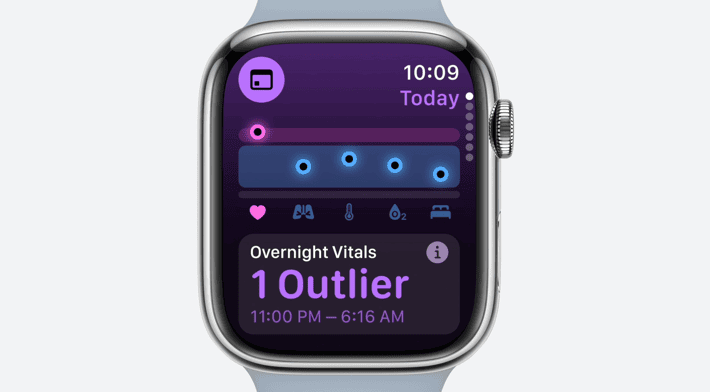
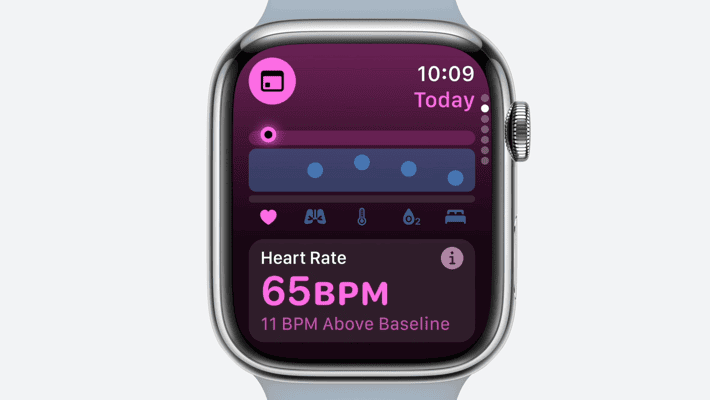
All this works fine, though, as noted, I’m surprised by the lack of notices around low sleep times. I’ve had some absurdly low sleep durations (like 3 hours), and never get an outlier notice. I’m not quite sure what you’d have to do to get one, and given the difficulty in getting that to trigger, it lessons the value of an app like this, if the goal is to make you aware of disturbing trends. I suppose you’re probably more aware of sleep time trending versus the other metrics (simply because you’re more tired), but still, it’s the only piece that doesn’t really fit for me.
In any case, ending this general section on something entirely different – there’s the new much faster charging times. The new Apple Watch Series 10 will now charge to 80% within 30 minutes. Frankly, it’s been incredible – and is spot on. Most of the technology to make this happen is within the back of the watch, though, it will need a newer model charger to get the faster speeds. Specifically one made in the last few years (either a braided one from the Ultra boxes, or one with silver/metal on the outside of teh charging puck, from Series 7 and newer).

Now this doesn’t impact the overall daily battery life, which remains at a claimed “18 hours all day battery life”. And in fact, Apple says the Series 10 should be seeing improvements in battery life. The said, I haven’t had that experience on my unit. For context, I burned through 17% battery last night while sleeping (with it in low-power sleep mode), and concurrently, over the last 60 minutes, I’ve burned through another 13% just sitting here writing. I’ve normally easily made it through the day on a single battery, including GPS time (and then charge right before bed). But with this unit, I’m barely making it past dinner each night before having to charge again.
Apple says this isn’t normal, and in talking to others testing the Apple Watch Series 10, they’re seeing substantially better better life than me (with more GPS time too). Thus, something seems off with my unit in some way/shape/form. I’ll continue to troubleshoot with Apple and circle back. Though, for GPS battery life, looking at yesterday’s 75 minute run as an example, it decreased from 39% to 24%, which would seem at least somewhat normal (implying about 12%/hour, or about 8.3 hours of GPS time per charge on the 45mm, which is above their claimed specs of 7 hours). Thus it seems the daily/general is more the problem, than workout usage.
In any case, let’s talk about those workout features.
Sports & Fitness Features:
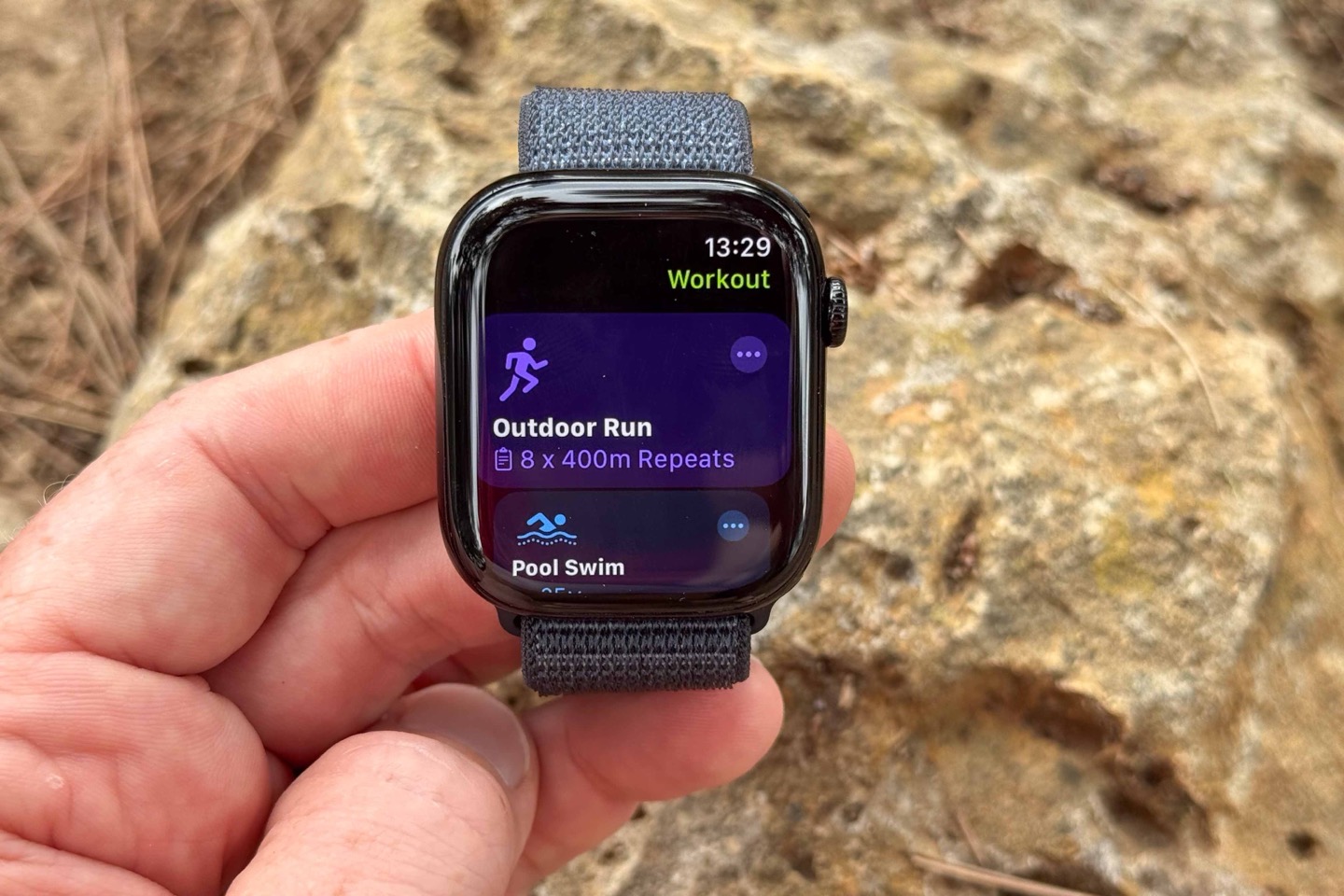
Apple continues to focus and increased their sports and workout related features, and this year is no different. Though, none of the new features were specific to Series 10, but rather via WatchOS11. So let’s dive into all the features, including both the new and previously existing bits.
First, to start a workout on the Series 10, you’ll tap the little runner icon, which opens up the Workout app. That’s the app that has all teh sport modes in it.
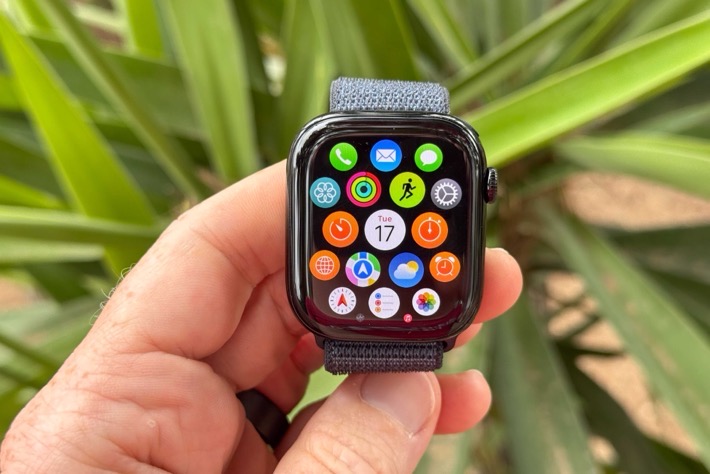
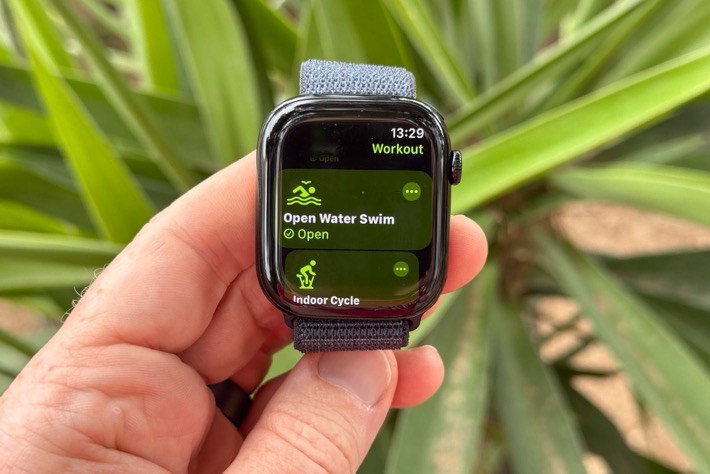
As of September 17th, 2024, here’s the complete listing of sports modes on the Series 10 (I had to manually write down this list, as Apple’s own list hasn’t been updated in forever):
– American Footbll
– Archery
– Australian Football
– Badminton
– Barre
– Baseball
– Baseketball
– Bowling
– Boxing
– Climbing
– Cooldown
– Core Training
– Cricket
– Cross Country Skiing
– Cross Training
– Curling
– Indoor Cycling
– Outdoor Cycling
– Dance
– Disc Sports
– Downhill Skiing
– Elliptical
– Equestrian Sports
– Fencing
– Fishing
– Fitness Gaming
– Flexibility
– Functional Strength Training
– Golf
– Gymnastics
– Hand Cycling
– Handball
– HIIT
– Hiking
– Indoor Hockey
– Outdoor Hockey
– Hunting
– Jump Rope
– Kickboxing
– Lacross
– Martial Arts
– Mind & Body
– Mixed Cardio
– Multisport
– Other
– Paddling
– Pickelball
– Pilates
– Play
– Racquetball
– Regret Writing This List Out
– Rolling
– Indoor Rowing
– Outdoor Rowing
– Rugby
– Indoor Run
– Outdoor Run
– Sailing
– Indoor Skating
– Outdoor Skating
– Snow Sports
– Snowboarding
– Indoor Soccer
– Outdoor Soccer
– Social Dance
– Softball
– Squash
– Stair Stepper
– Stairs
– Step Training
– Surfing
– Open Water Swim
– Pool Swim
– Table Tennis
– Tai Chi
– Tennis
– Track & Field
– Traditional Strength Training
– Volleyball
– Indoor Walk
– Outdoor Walk
– Water Fitness
– Water Polo
– Water Sports
– Wrestling
– Yoga
Ok then…that was a dumb idea to write all those out. But once I got into it deep enough to realize it, I was committed. You’re welcome.
In any event, your favorites are listed towards the top of the list, so in my case, let’s just go with ‘Outdoor Run’. Here, I can select it to immediately start it, or, I can tap the ‘…’ to configure settings.
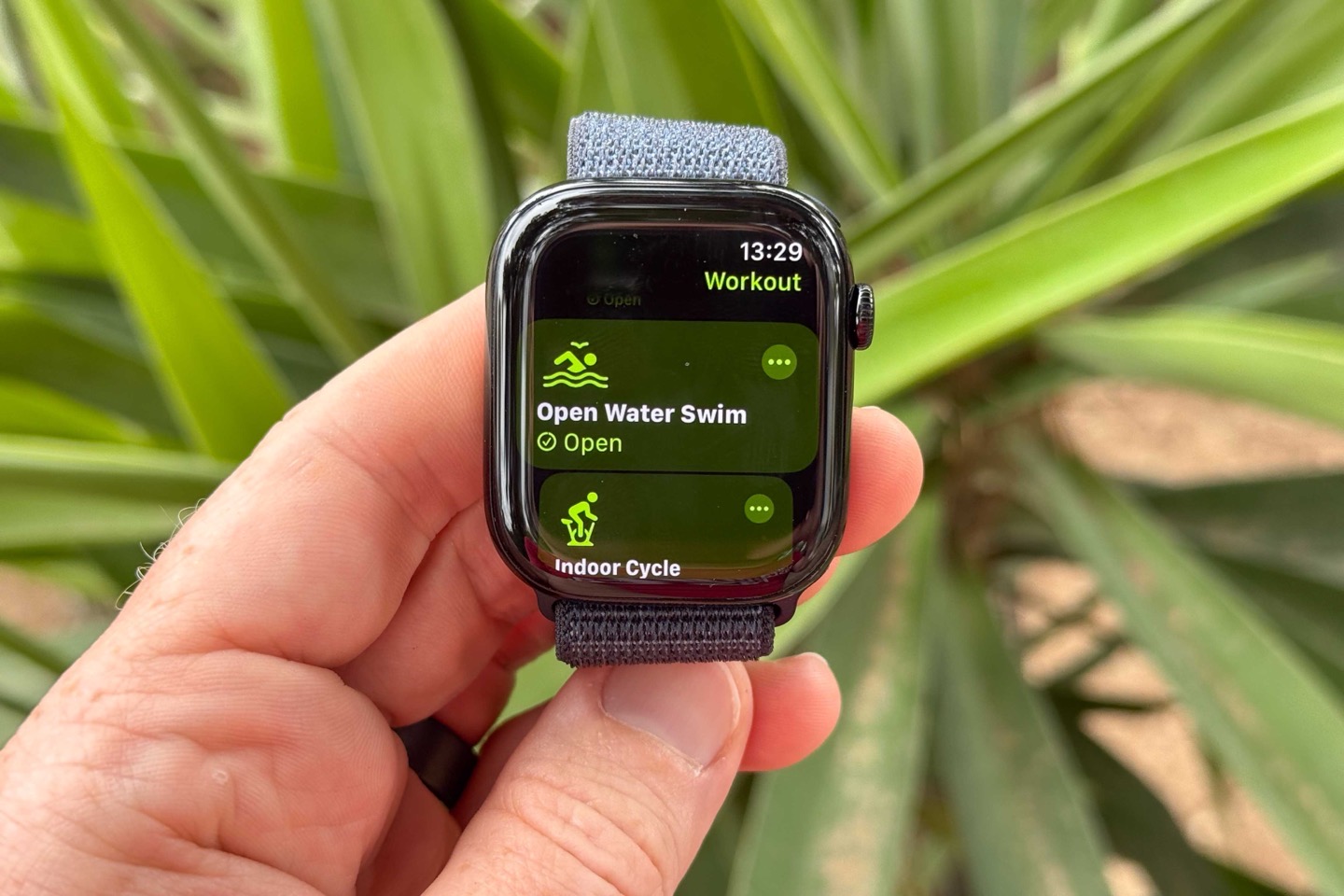
By selecting the settings, I can change the target (such as a time/distance goal), race against a previous route, as well as create a structured workout.
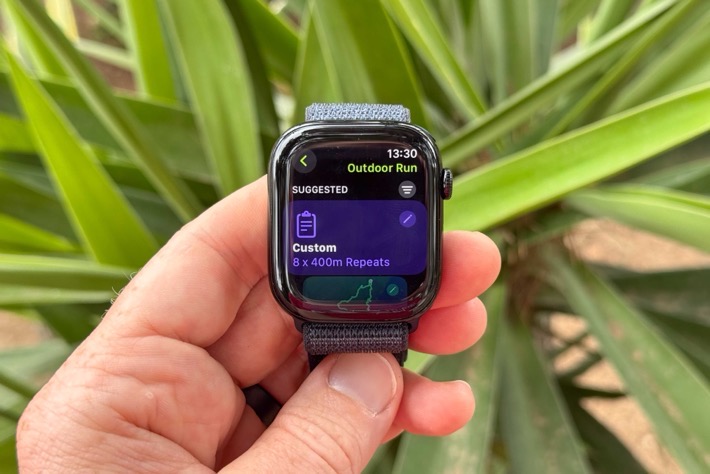

The structured workouts can be created directly on the watch, including rather complex interval workouts, or, you can use sync from a slate of 3rd party partners, including companies like TrainingPeaks, to automatically import your scheduled workouts from those platforms to the watch. This includes running, cycling, and new to WatchOS11, structured swimming workouts.
You can also tweak your display preferences here, in terms of which data fields/pages you want. Apple has a pile of them, though they still won’t reach the flexibility levels seen on more endurance-focused watches. And interestingly, despite now having a larger display area than the Apple Watch Ultra series, you’re still limited to the same existing data field quantity/sizes (whereas the Apple Watch Ultra series lets you see more data fields per page).
In any event, let’s start a run. As expected, during the workout you’ll see any data pages you’ve configured, and you can scroll through them by using either touch or the Digital Crown:
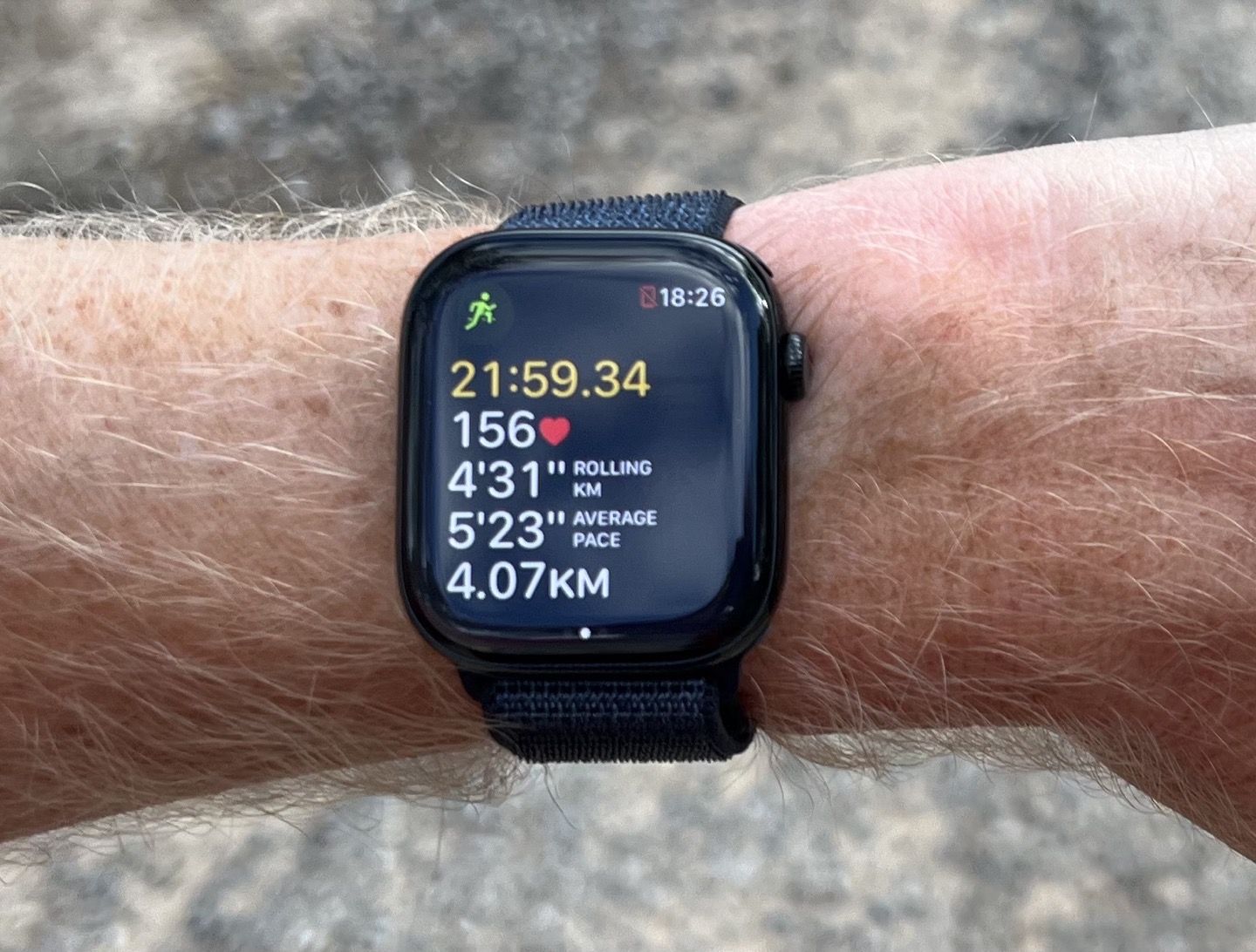
None of this is any different from before.
However, what is new is the ability to download offline map sections to the watch, and create pedestrian routes to follow. Previously you could download maps to your phone, but you still had to have your phone with you. Now, the phone isn’t required. To download these maps, you’ll open the Apple Maps app on your phone, and then download it to your phone. With that, there will be an option to also “Sync with Apple Watch”, which will do so once the watch is on the charger:
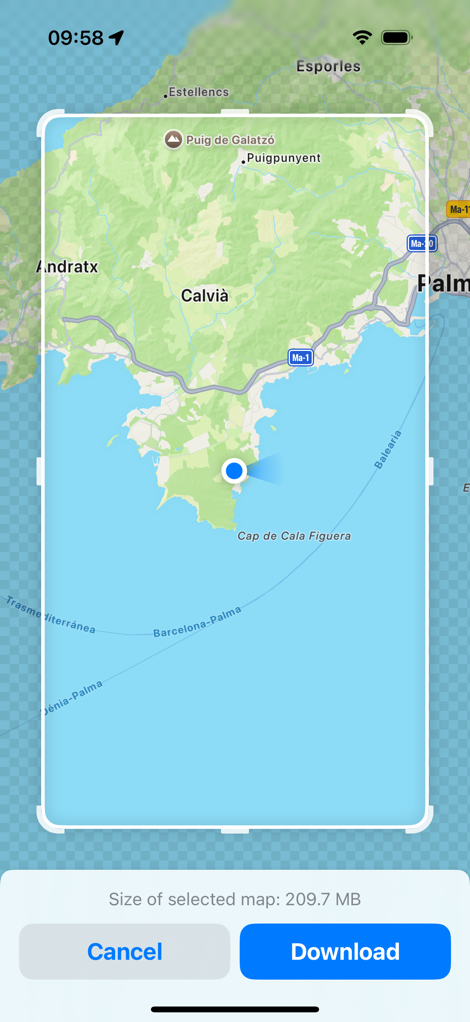

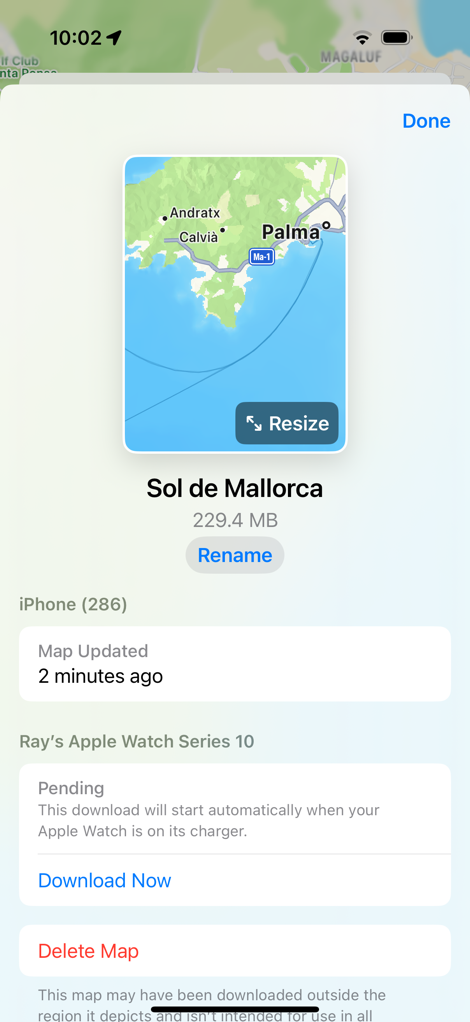
Then, within the Apple Maps app, you can download and/or create routes for pedestrian use. This includes picking from pre-populated routes for the area, or, simply tapping your way through creating a route, as I did for my trail run this past weekend.
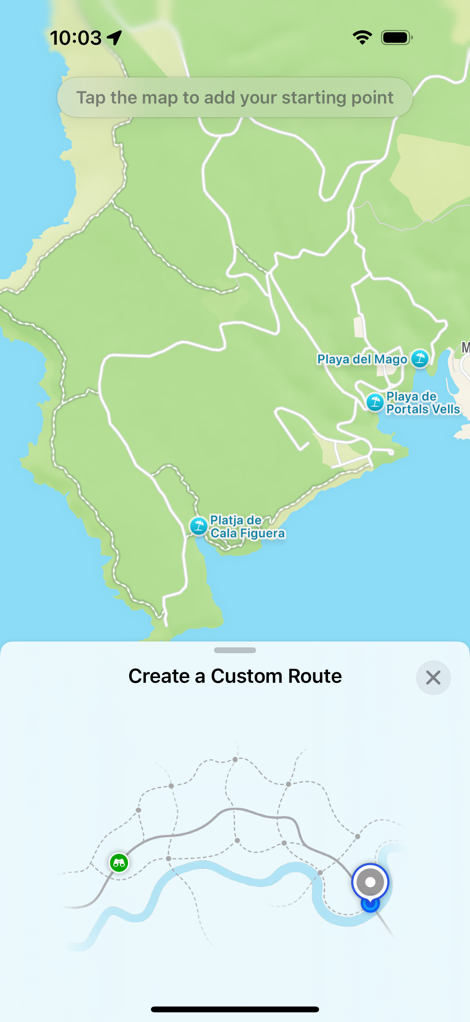
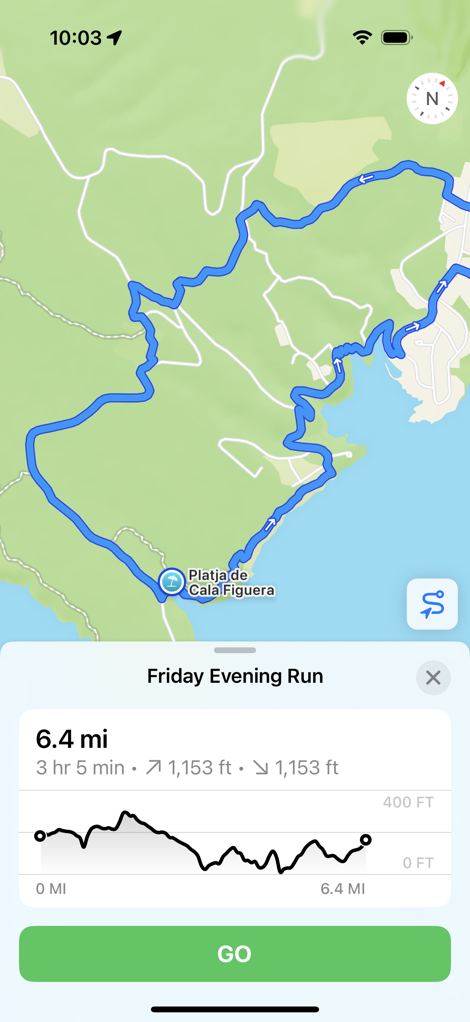
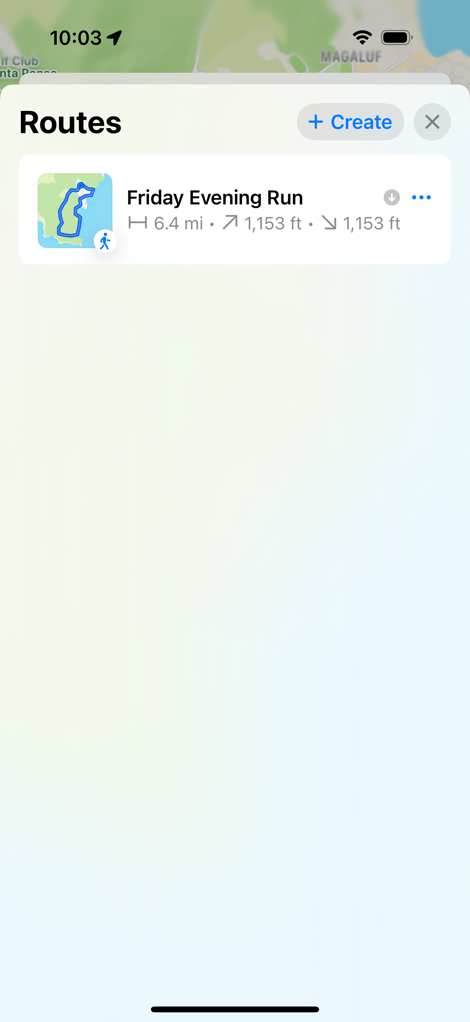
Next, out on the run you can see these maps/routes (and again, this is a feature of WatchOS 11). In this case here’s a photo showing it on the Apple Watch Ultra 2 (whereas I had data on the Series 10), though, it’s identical from a functional standpoint. It’ll notify you of upcoming turns automatically, and show you the route on the screen. As you can see, this worked on a trail, it didn’t require any sort of road.

While this works OK, it’s clear Apple needs the same sort of 3rd party connection/API that it has for the structured workout side, so that apps like Strava, Komoot, MapMyRun, etc… can push routes to the Apple Watch. The route builder within the Maps app is fairly limiting in terms of creating routes, except for the most basic of scenarios (for example, it lacks elements like heatmap data). Whereas all of Apple’s partners have the capabilities to make this happen. Hopefully, that’s on the list for WatchOS12 next year.
With my run in the woods successfully navigated, you’ll end the workout to save the data.
One of the new items you’ll see in that list is the Effort Rating. That’s a new WatchOS11 feature that has your rate the difficulty of that workout. That serves as the basis for the training load components. I dive into this in much more detail in this post, but essentially it takes your effort rating, and multiplies it by your duration, to get total training load. Apple attempts to calculate an Effort Rating upfront, though, I find it basically rates everything a 7 for me.
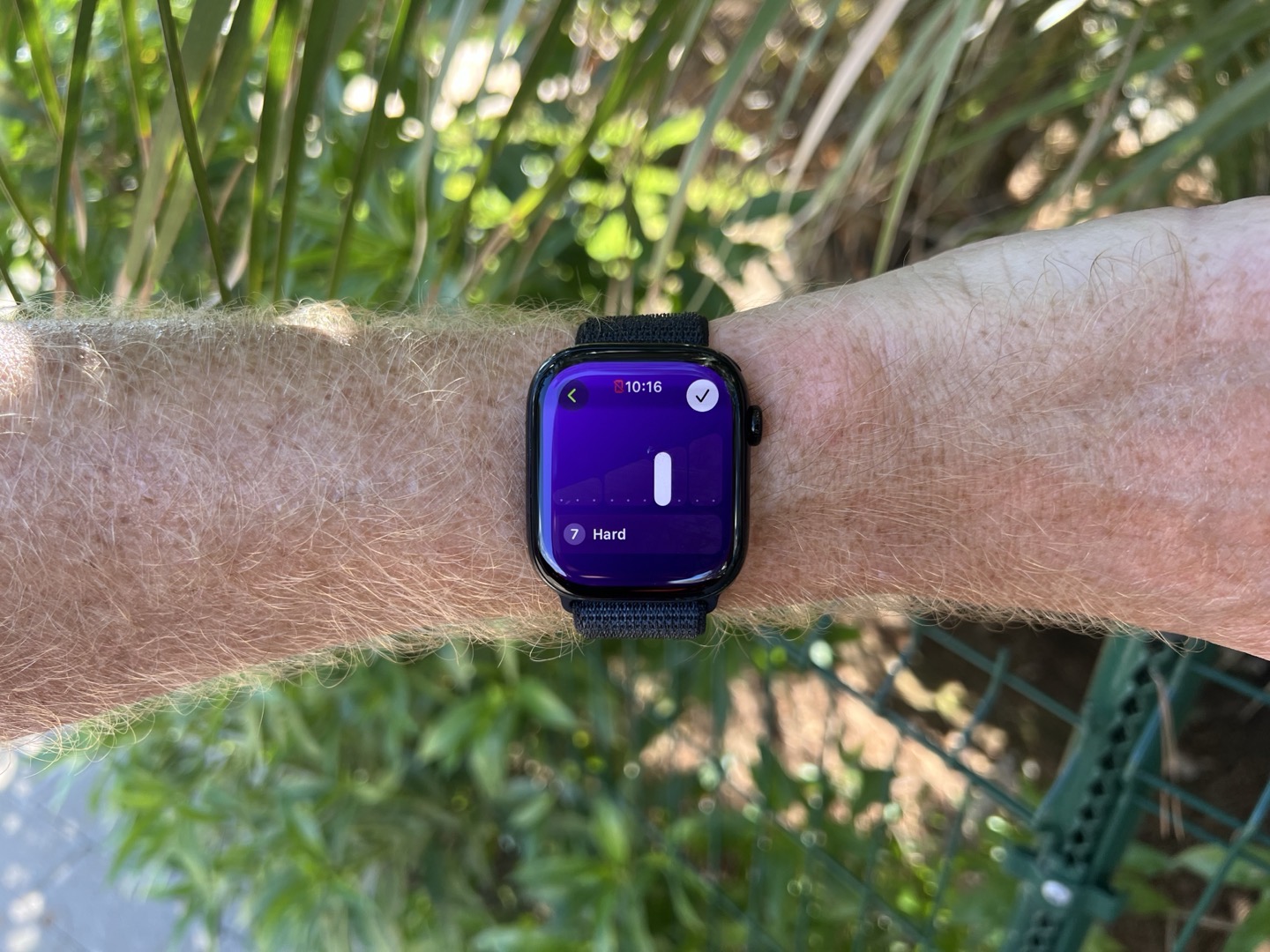
Likewise, you can see this data on the Fitness app, in much more detail, including metrics like running power and running efficiency data.


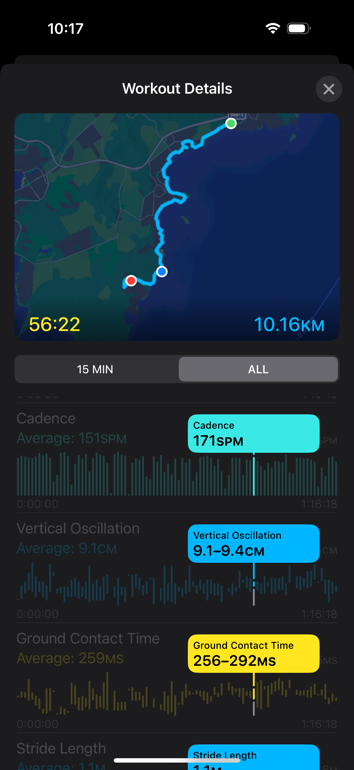
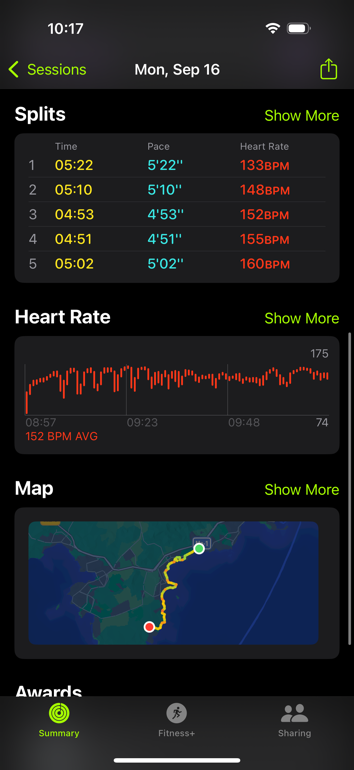
In my case, I then use the 3rd party app HealthFit, to sync it onwards to various other platforms, as well as display other analytics (it’s also how I get the data out for the accuracy pieces down below):
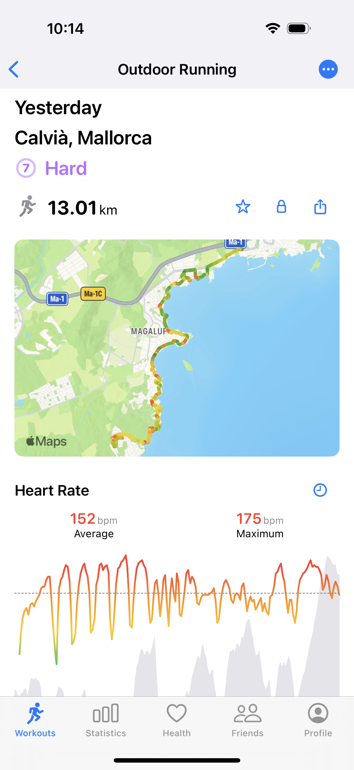

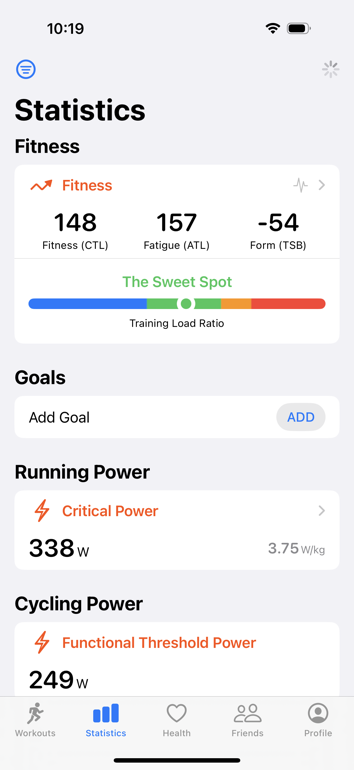
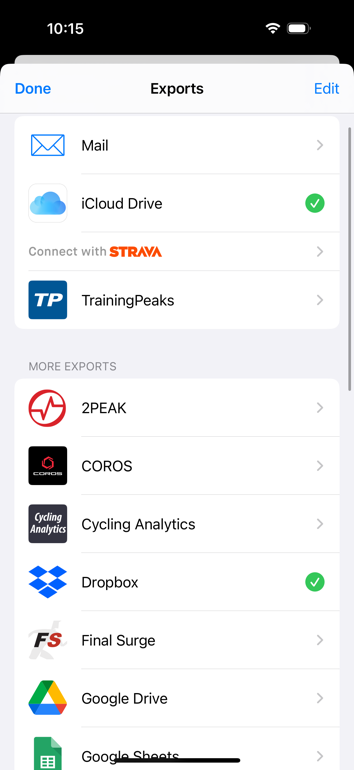
Meanwhile, back in native Apple land, there’s the new training load features (again, covered in-depth here, from WatchOS11). On the watch, you’ll see your training load displayed, over your baseline. This is comparing your current 7 days, against your previous 28 day average/baseline (to access this, open the ‘Activity’ app on your watch, then tap the upper right corner icon.

You can scroll along each of the 7 days to see how it compares. You’ll see an indicator showing if it’s normal, or above/below the baselines (or ‘Well’ above/below the baseline). My only challenge with this, and it’s kind of a big challenge, is that it doesn’t provide an actual load number like every other companies. Obviously, Apple has that number (and it’s not really a secret), because that’s how it shows the % difference. The problem with not showing a number is you can’t really compare different timeframes.
For example, by 80% “Well Above” from today, is that really all that above? Or, is it just that my current 28 day period on the Apple Watch is a bit lower due to seasonability or travel? If I’m looking at this from an athletic/endurance standpoint, I want to know how things compare between different months, not just the last four weeks. Apple could easily solve this by just showing the actual load number on the screen (or, even in the app), like every other company. Speaking of which, you can see this within the app too:
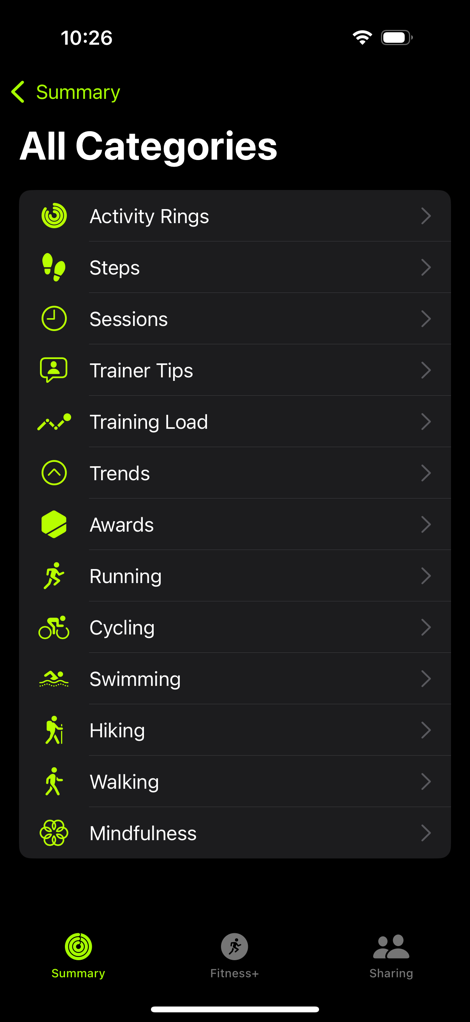
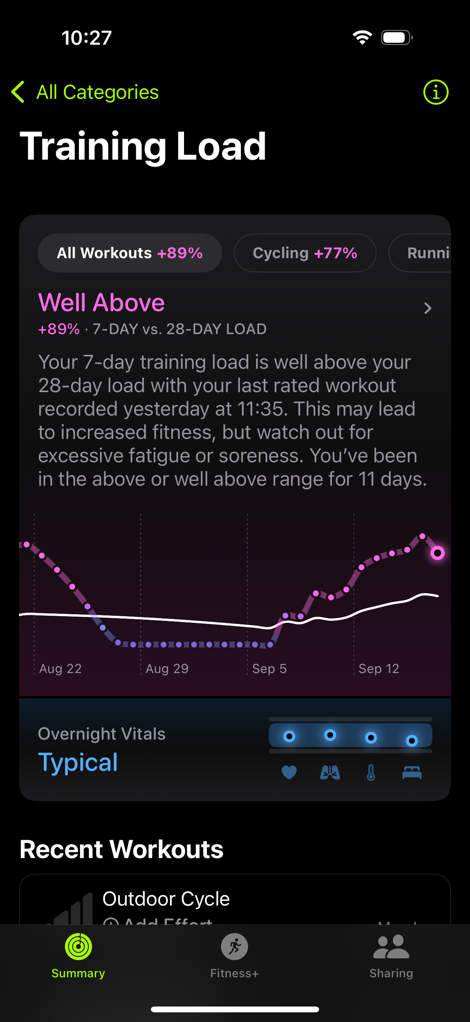
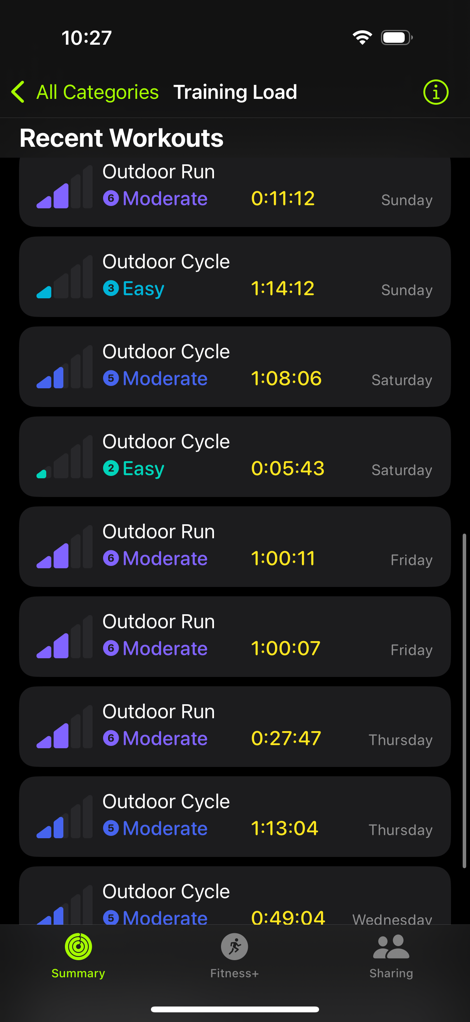
And in fact, my data is such a great example of why they need numbers. Due to only having two wrists, and numerous watches to test, I took off the Apple Watch for a few weeks in August. As such, you see that gap there. Thus, my 89% higher than normal load isn’t real (since in fact I was doing huge workouts then). While Apple can account for other Apple Watch apps pushing data into the training load calculations, it doesn’t account for other platforms. No biggie, but again, if I just had an actual number here, then I’d easily be able to look at it and go “Oh, ok, my current load this week is normal/high/low/etc for me seasonally”, just like I do on other watches.
In any event, I do appreciate Apple getting into this realm, I just wish this was slightly more skewed towards the folks it’s realistically targeting.
Now, a few other odds and ends. From a sensor standpoint, the Apple Watch can connect to various Bluetooth fitness sensors, including external heart rate sensors, and cycling sensors. This includes cycling power meters, cadence sensors, and even smart trainers. While it can’t control smart trainers, it can read data from Bluetooth FTMS trainers (which is every trainer in the last half a decade+).

And, in my testing, that continues to work very well (it was introduced last year in WatchOS 10).
However, inversely, Apple doesn’t have any broadcasting of your heart rate via normal Bluetooth standards. Sure, a handful of devices will use Apple’s GymKit feature to access your heart rate, but when I say ‘handful’, I mean almost none these days. It’s unclear to me why Apple is so hesitant on this area, which would make it much easier to broadcast your heart rate to other devices (including bike computers). In effect, it basically forces cyclists (the very people Apple added power meter support for), to use other 3rd party products to get heart rate data onto their bike computers (as most serious cyclists aren’t using Apple’s bike phone companion app/feature on their handlebars). Hopefully they’ll consider adding that down the road.
Overall though, Apple continues to round out its sports and fitness features. It’s clear in the 2024 hardware/software updates, that it’s not trying to be a Garmin in terms of sports depth, but rather, trying to be just deep enough to tempt those that don’t need all the Garmin features, with just enough features to cover the majority of use cases. And thus far, it’s mostly threading the needle well.
New Depth Gauge (Snorkeling):
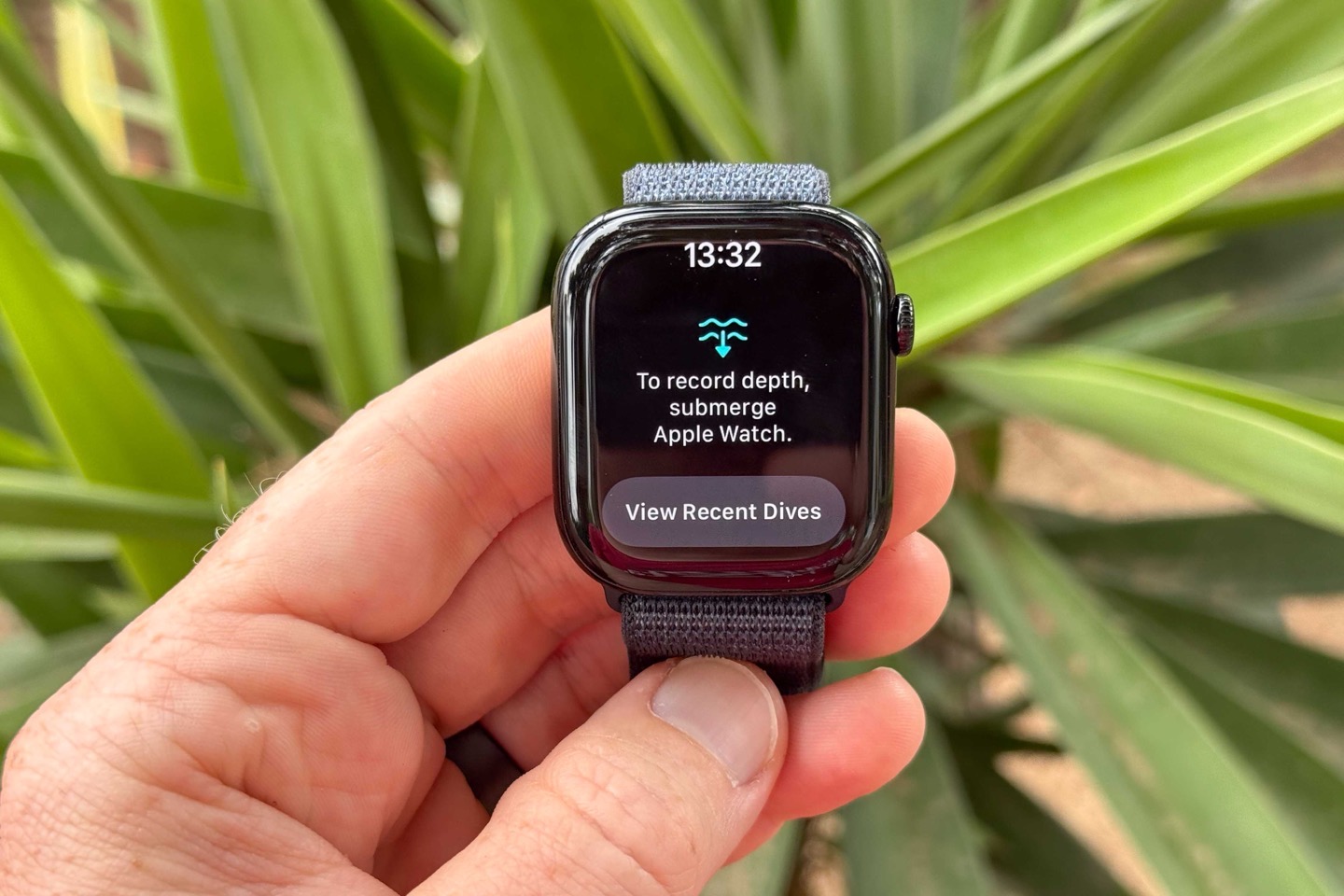
You’ll note that this section is separate from the Sports & Fitness features. Sure, one could assume that’s because I wanted to highlight the new depth gauge feature that’s marketed specifically towards snorkeling. But unfortunately, that’s not the case. The reason it’s separate is because within Apple’s software realm, it’s not considered a sport. Somehow, Rather, it’s an entirely different ‘situation’.
While ‘Social Dance’, ‘Bowling’, ‘Sailing’, ‘Paddling’, and ‘Hunting’ are all sport profiles, somehow snorkeling is not. Even worse, it’s relegated to the ‘Depth’ app. And look, I’ll say upfront this entire thing is very salvageable via simple software updates. But right now, this is nothing short of a hot mess. Not quite dumpster fire status, but, not far away either.
You see, the ‘Depth’ app was introduced with the Apple Watch Ultra series, to allow scuba diving. But Apple didn’t really want to get into the business of being a true dive computer (with all the baggage that has), so instead Apple made the depth gauge/app, and offloaded all the messiness to Oceanic and their Oceanic+ app (which requires a subscription). That meant Apple did the hardware work of certifying the dive gauge per all the required standards, and Oceanic did the work of doing the same on the software side. Life was (mostly, grand).
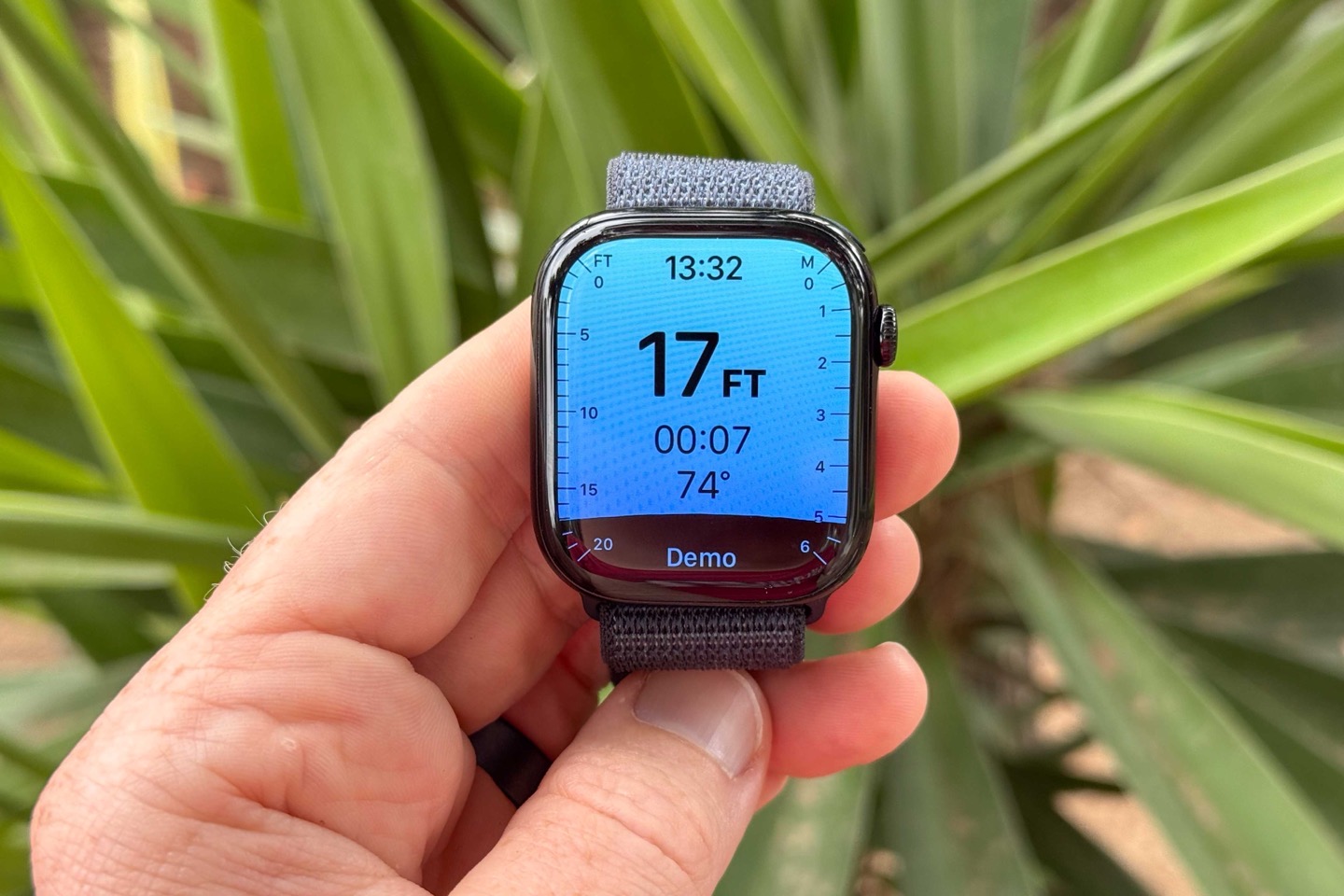
Then, came along Apple Watch Series 10, with its little sibling depth gauge. While the Apple Watch Ultra has case protection down to 100m, the depth gauge is only certified to 40m. Meanwhile, for the Series 10, it’s only declared down to 6m/20ft. Which, is perfect for snorkeling (but useless for diving).
To the end, the built-in (and free) Apple Watch ‘Depth’ app shows your current depth and ‘dive’ time, as well as water temperature (per above).
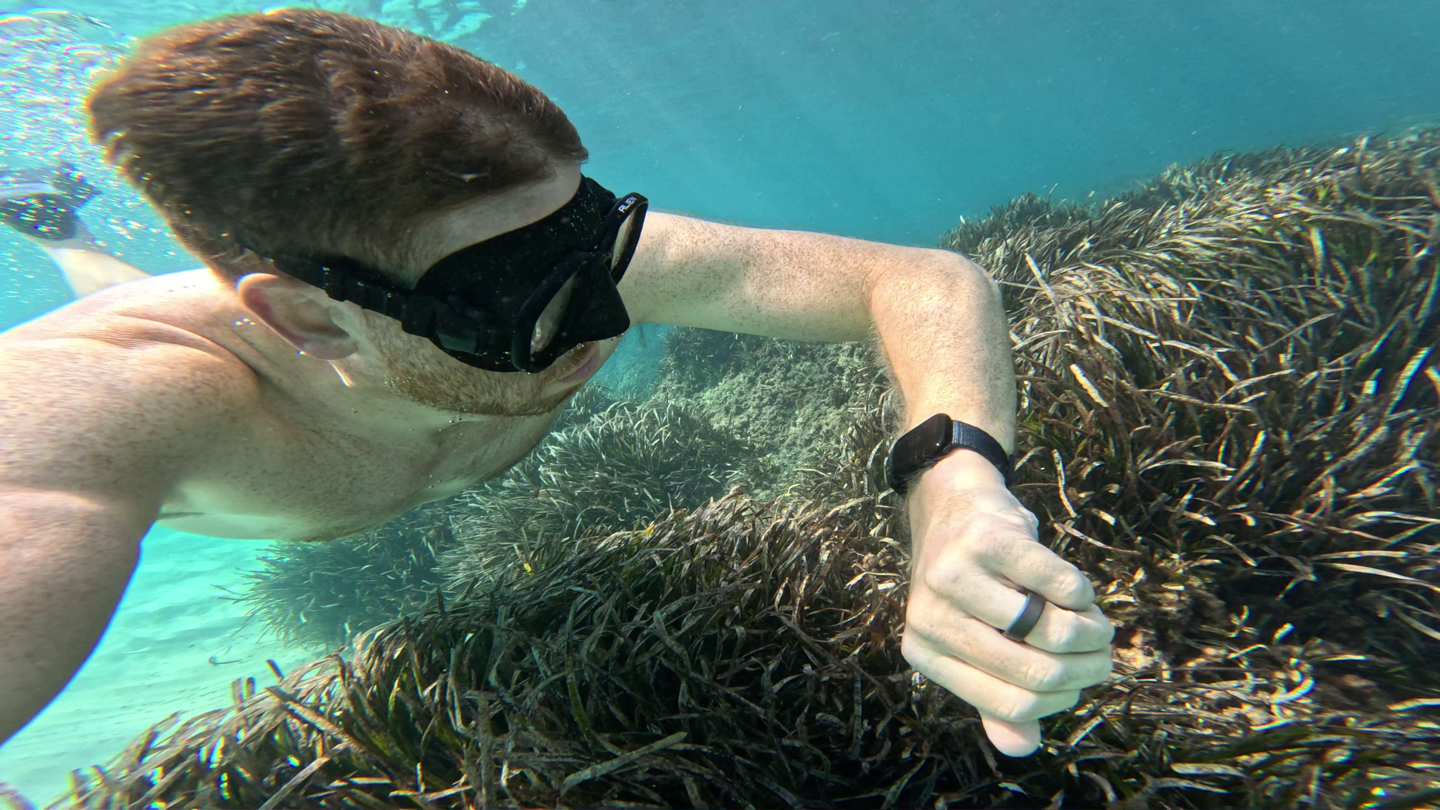
Except for one problem: It resets anytime you come within 3ft of the surface. Thus, you can’t actually track your snorkel session, as it resets it every few seconds (and sometimes shows water temp and sometimes doesn’t), and then fills up your Apple Fitness app with a gazillion ‘Depth’ activities of a few seconds:
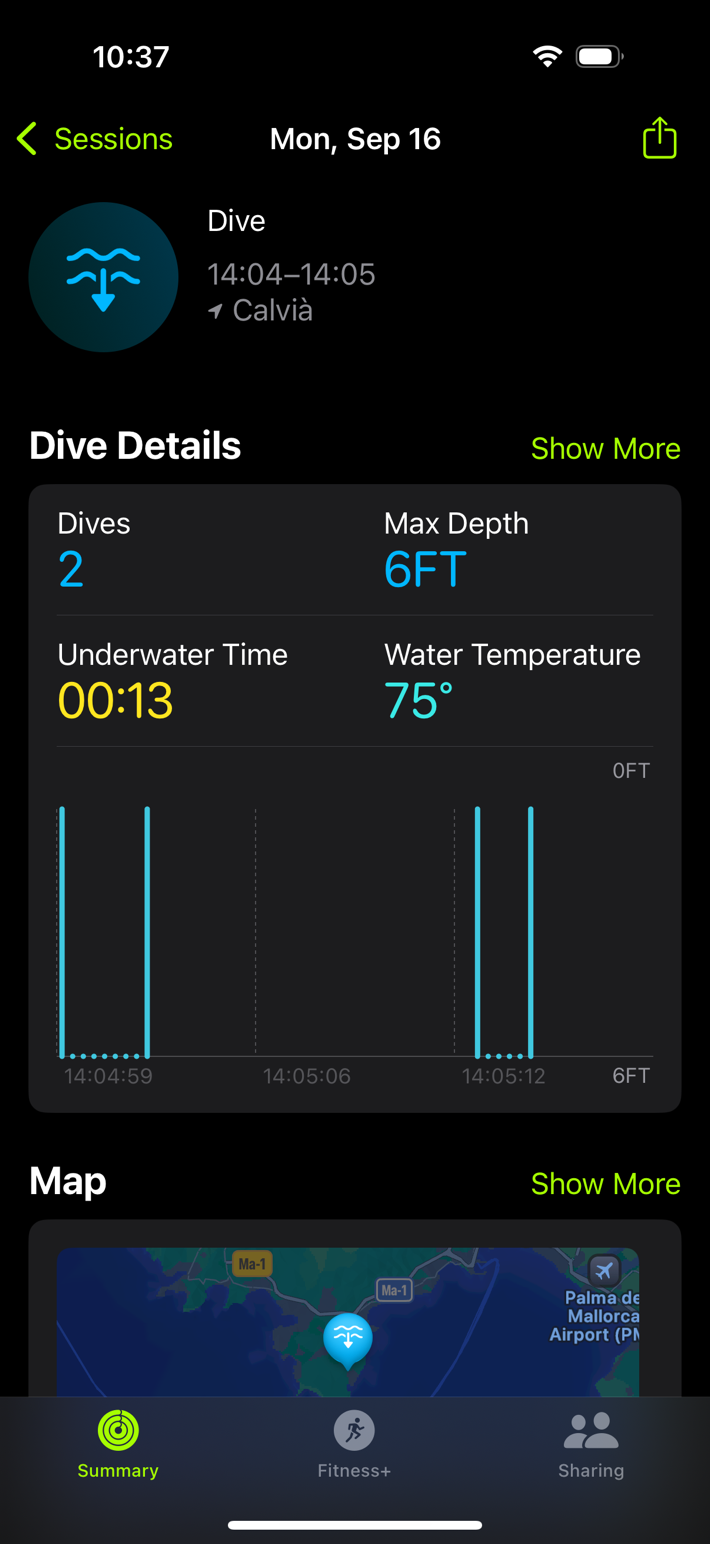
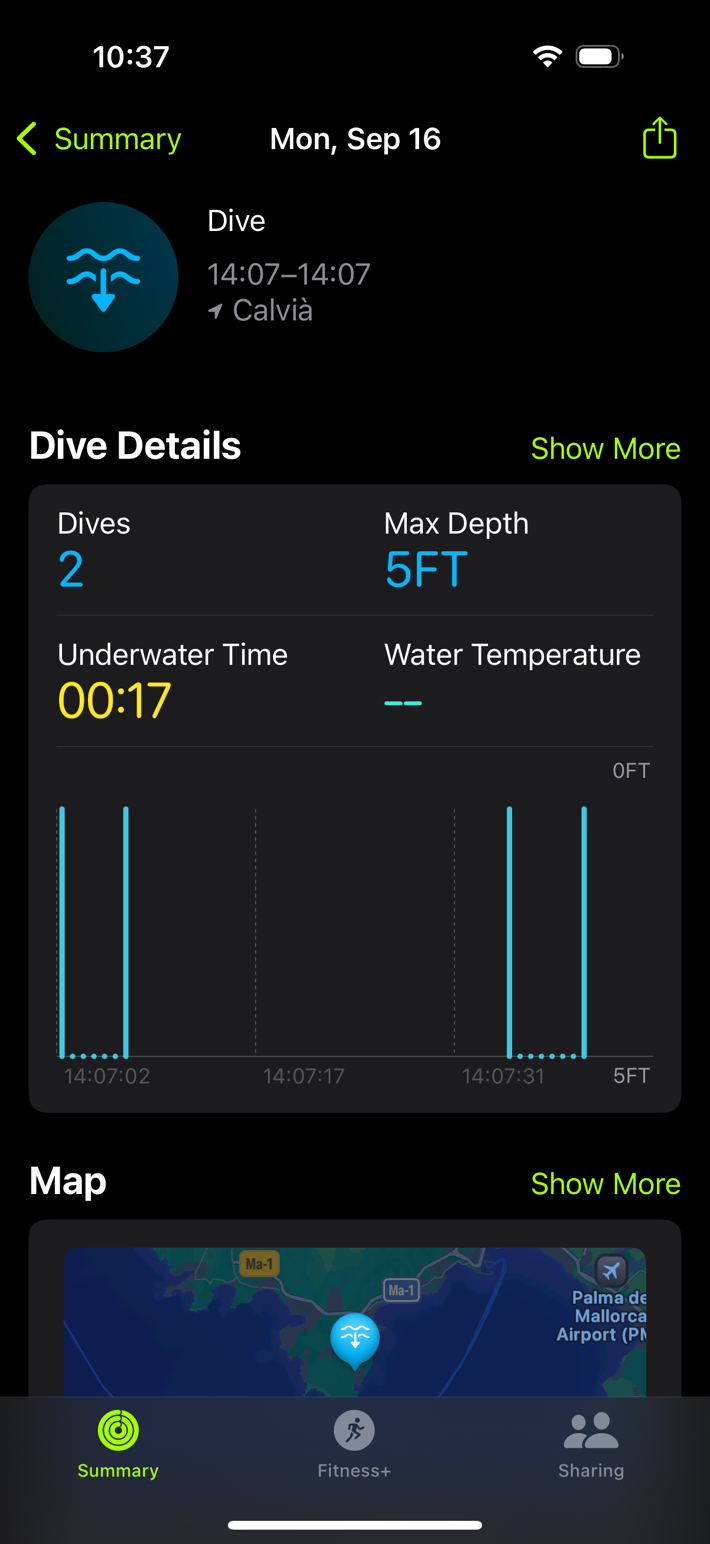
Why on earth this couldn’t have been a simple workout/sport type is well beyond me. After all, if you go for a swim, Apple records the water temp/time/distance/etc there. The same goes for sailing, paddling, and you name it. All that data ends up in Apple Health, just like the Depth app. There’s simply no logical reason the same couldn’t have been done for snorkeling.
Instead, they push you over to Oceanic’s app. That app works well on Apple Watch Ultra, but alas, isn’t fully ready for Apple Watch Series 10. Yes, the app itself installs fine on the Series 10, and during your snorkeling session, it does correctly track each ‘dive’ down to the bottom, the max depth, per-dive time, and even a compass. On the watch itself, this actually works mostly well – and is exactly what Apple should have natively.
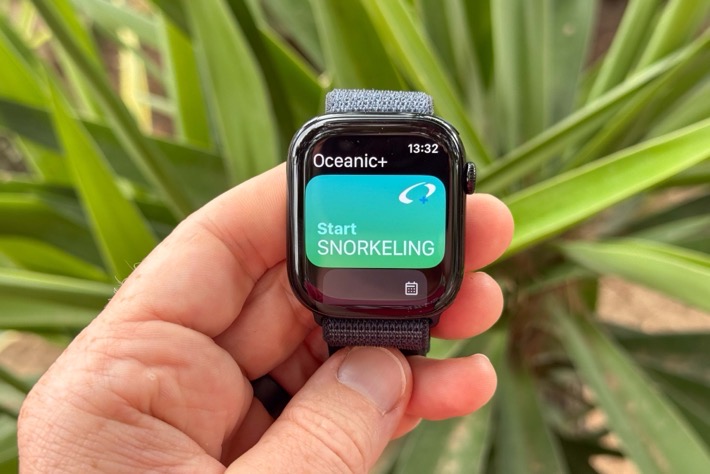
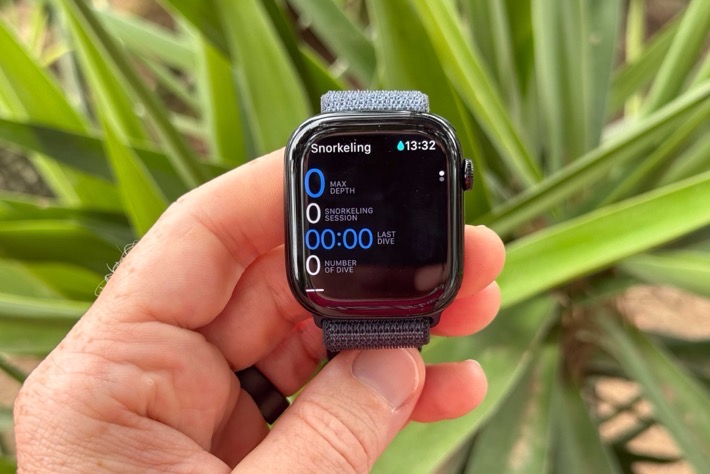
I realized I never took pretty underwater photos of the actual Oceanic app mid-snorkel. Sorry, So instead, here a pretty picture of us underwater snorkeling.

However, the Oceanic phone app isn’t ready yet for Series 10. Thus at present it’s missing almost all the data it should have (no depth data, no GPS data, no dive map, no photos, etc…). Basically, the only thing it has is time of day and total duration. A far cry from what was shown in the Apple Keynote:
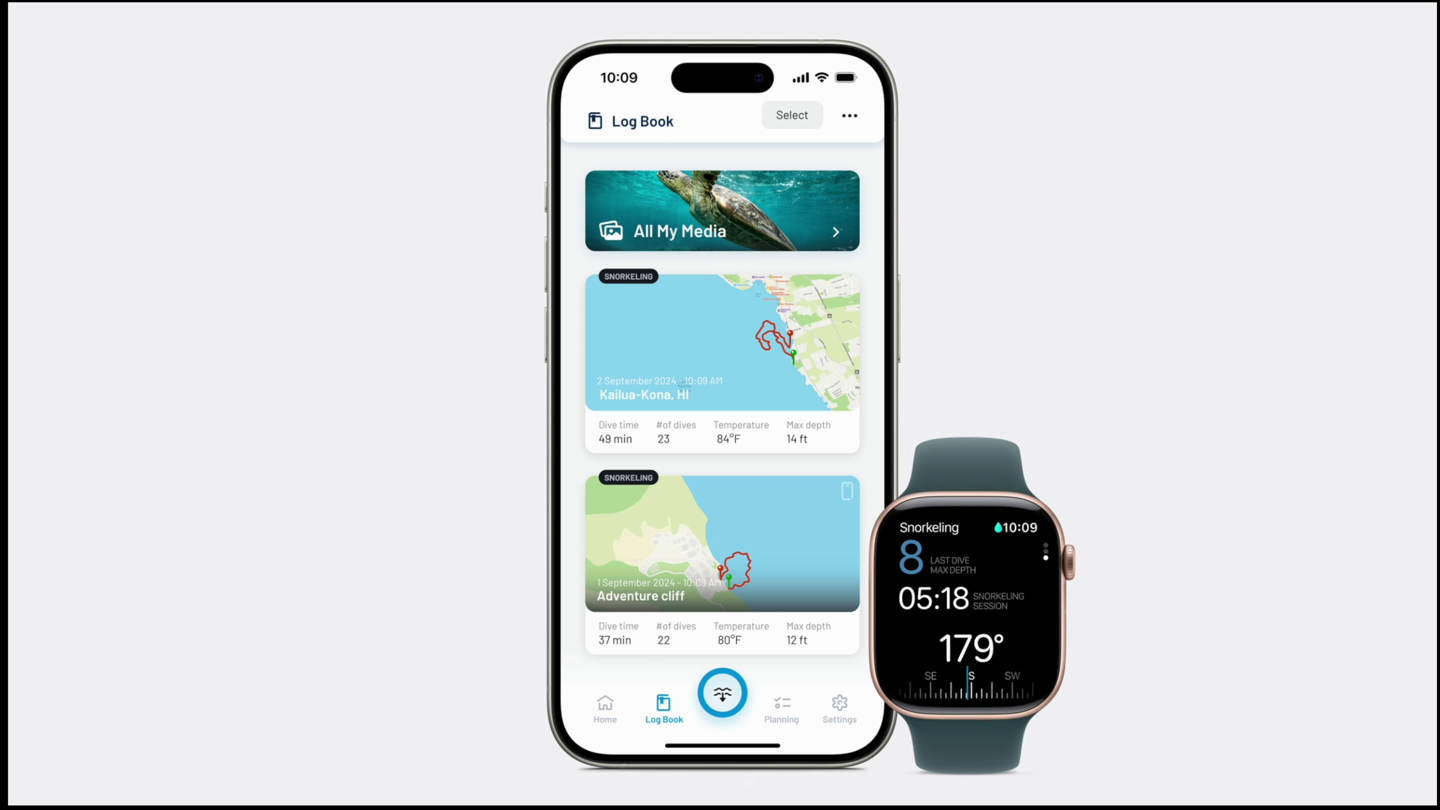
I’ll have to circle back on this once Oceanic gets their app finished. Still, setting Oceanic aside for a second, this could be a cool feature if Apple simply made it a sport profile like every other sport profile. Or, if they just had the Depth app simply keep everything as one singular session, rather than creating a new activity every time you bobbed your head underwater for a few seconds. While I appreciate the extra features the Oceanic App has on the scuba diving side, for the snorkeling side, it seems like this was offloaded to them without any clear reasoning as to why – or how that ultimately benefited the Apple customer.
On the bright side, the new Tides app is great – and arguably one of the most refined things I’ve seen Apple do this year (and by far, the best watch manufacturer-provided implementation of tidal data). The Tides app will automatically show tides for the nearest spot to your current location:
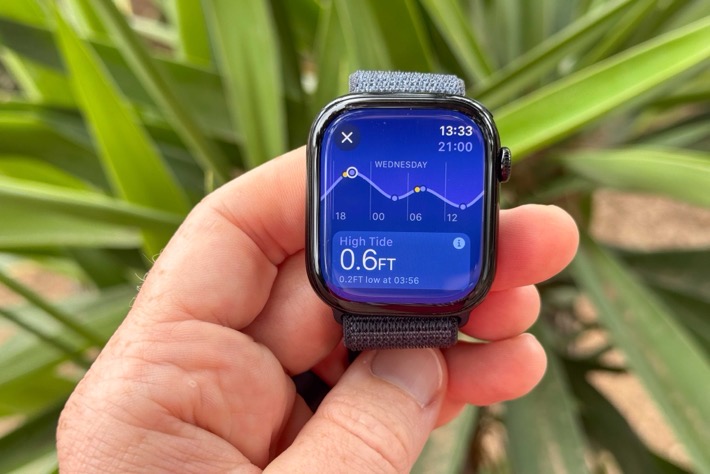
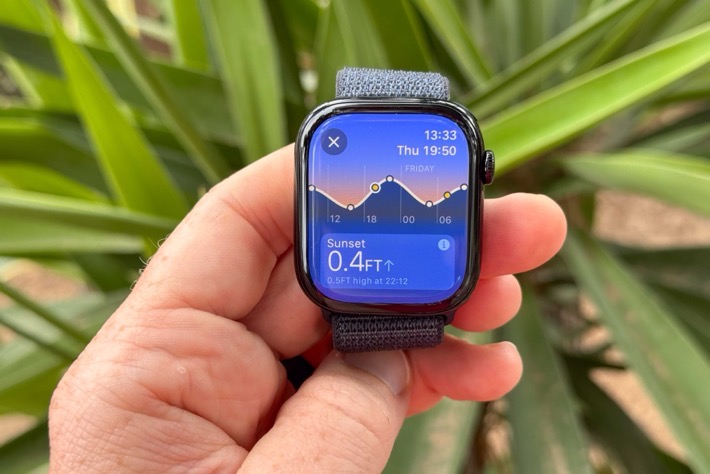
You can scroll along use the digital crown, and see the upcoming 7 days of tidal data. The implementation is just super clean and easy to read, and well done. So much data is conveyed in a very simple format.
In addition to your current location, you can also search from 150,000 other locations, saving those spots to the app as well. Further, you can tap on the current location to see swell information:

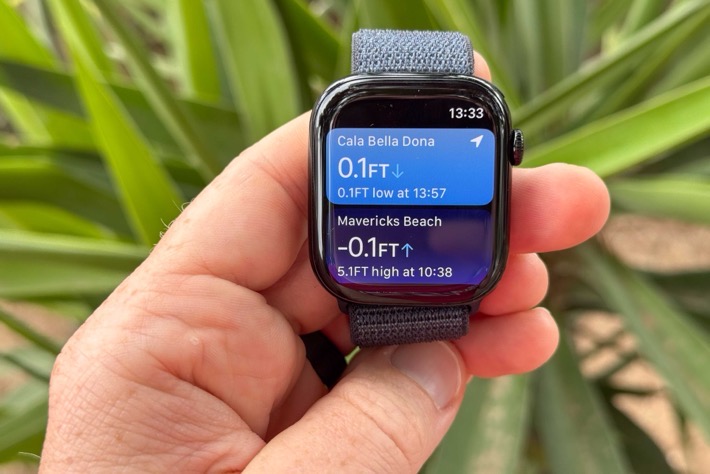
Note that the Tides app is now available for all WatchOS 11 watches, so it’s not just limited to the Series 10.
GPS & Heart Rate Accuracy:
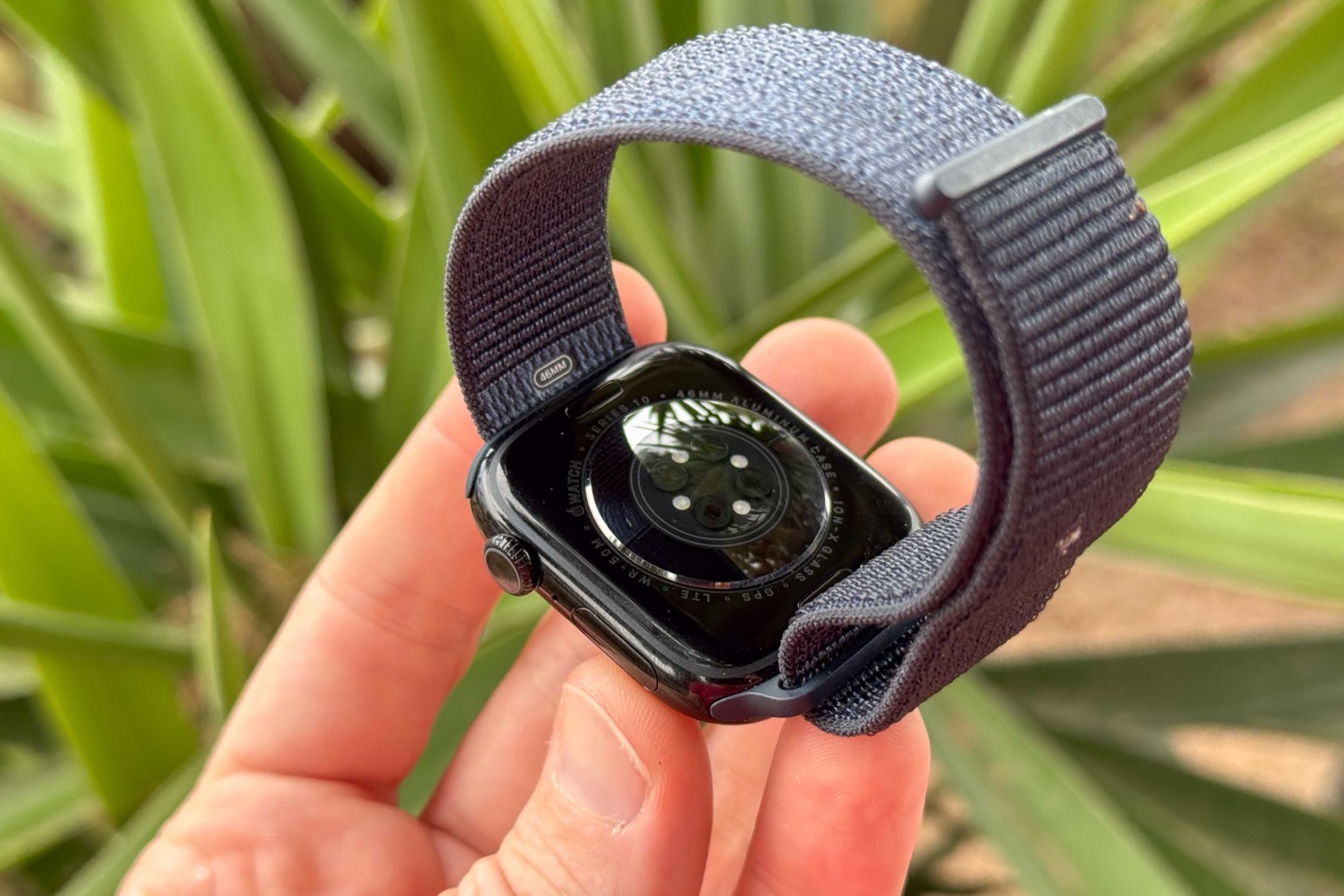
There’s been no changes in either GPS or heart rate sensors on the Apple Watch Series 10, as compared to the Series 9. Likewise for the Apple Watch Ultra 2 Black, versus the Apple Watch Ultra 2. That said, aspects like new case designs can (and definitely will) potentially have an impact on accuracy of GPS, as the antenna for GPS is usually around the outer edge of the case. I always validate accuracy of every new model, as I’m doing here for the new Titanium edition of the Series 10.
Starting off on the heart rate side, we’ve got a trail run I did this weekend. This wasn’t an interval run per se, though, kinda ended up as one as I went up/down the various hills in the area. Here’s that data set:
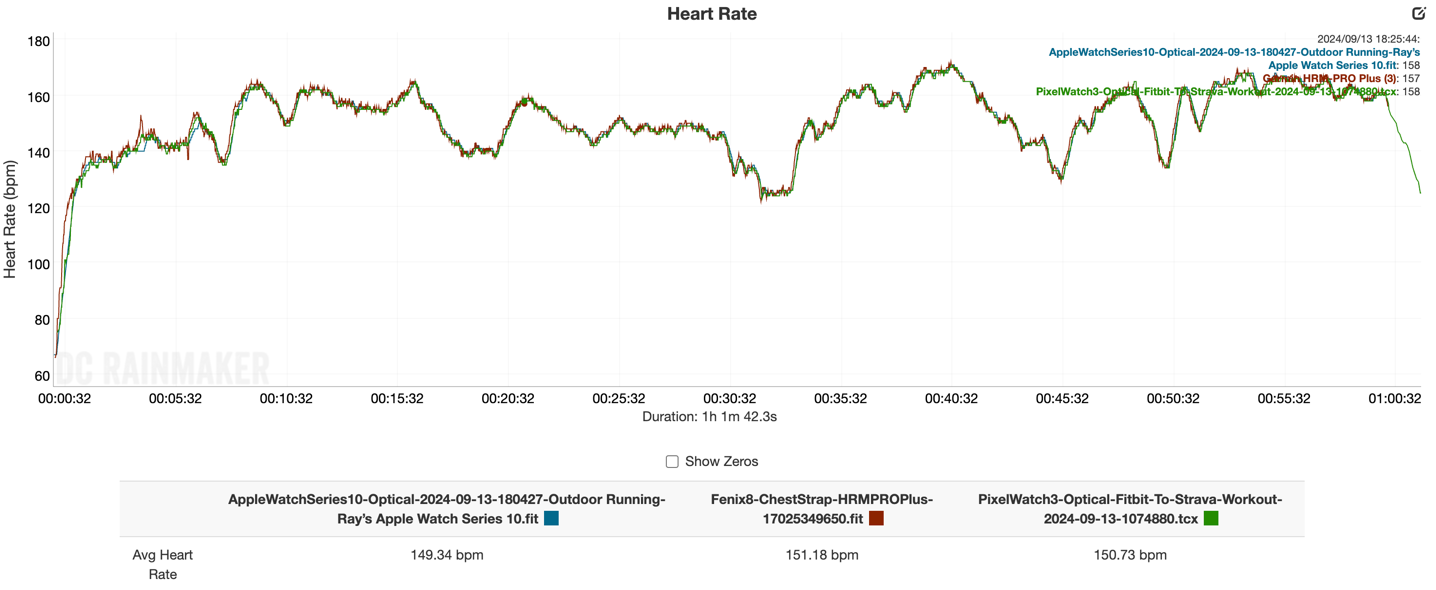
As you can see, there’s clearly no meaningful difference. It’s spot-on with the chest strap, as well as the Google Pixel Watch 3 on the other wrist.
Next, here’s yesterday morning’s interval run, which…well…was painful. It initially started on pavement, but then transitioned to dirt and eventually just all sorts of trails. Here’s that compared to the same chest strap and Pixel Watch 3:
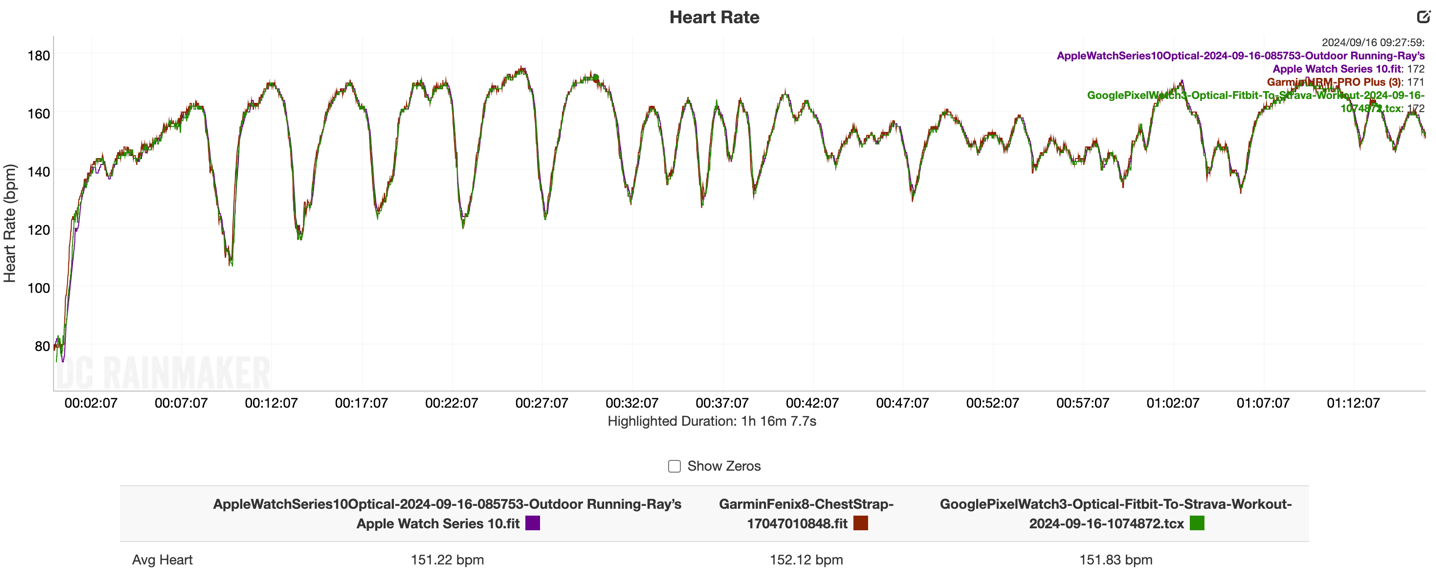
Again, it’s spot-on perfect. Honestly, this is kinda getting boring.
So, let’s step it up and look at a gravel bike ride. Or rather, some road riding, some gravel, and some MTB, all in one. Here’s that data set:

As you can see, it’s very close, but, we can see some slight minor struggles from the Series 10 in some areas in terms of delay (above or below). The Pixel Watch made a few minor errors here and there too, and in total, I’d call it a wash between those two on this ride.
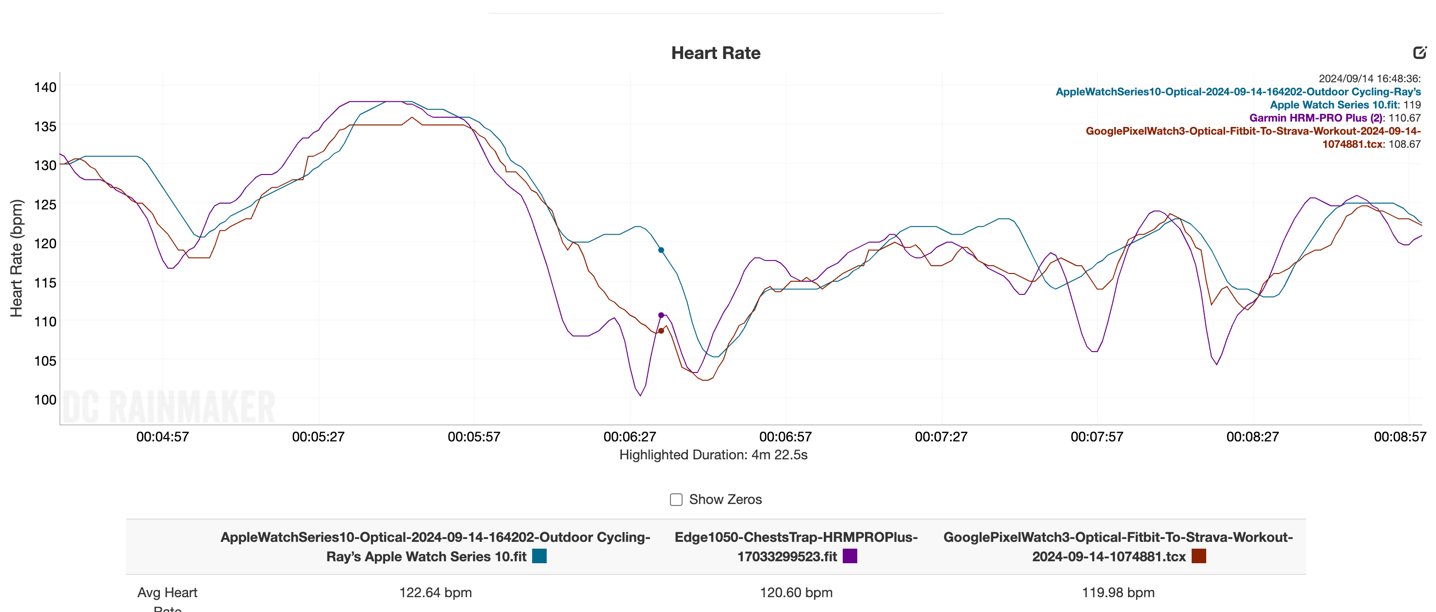
Looking at some GPS tracks, we continue to see no issues in GPS accuracy. Here’s a trail run I did, starting at a high level, again, this looks identical to the other units:
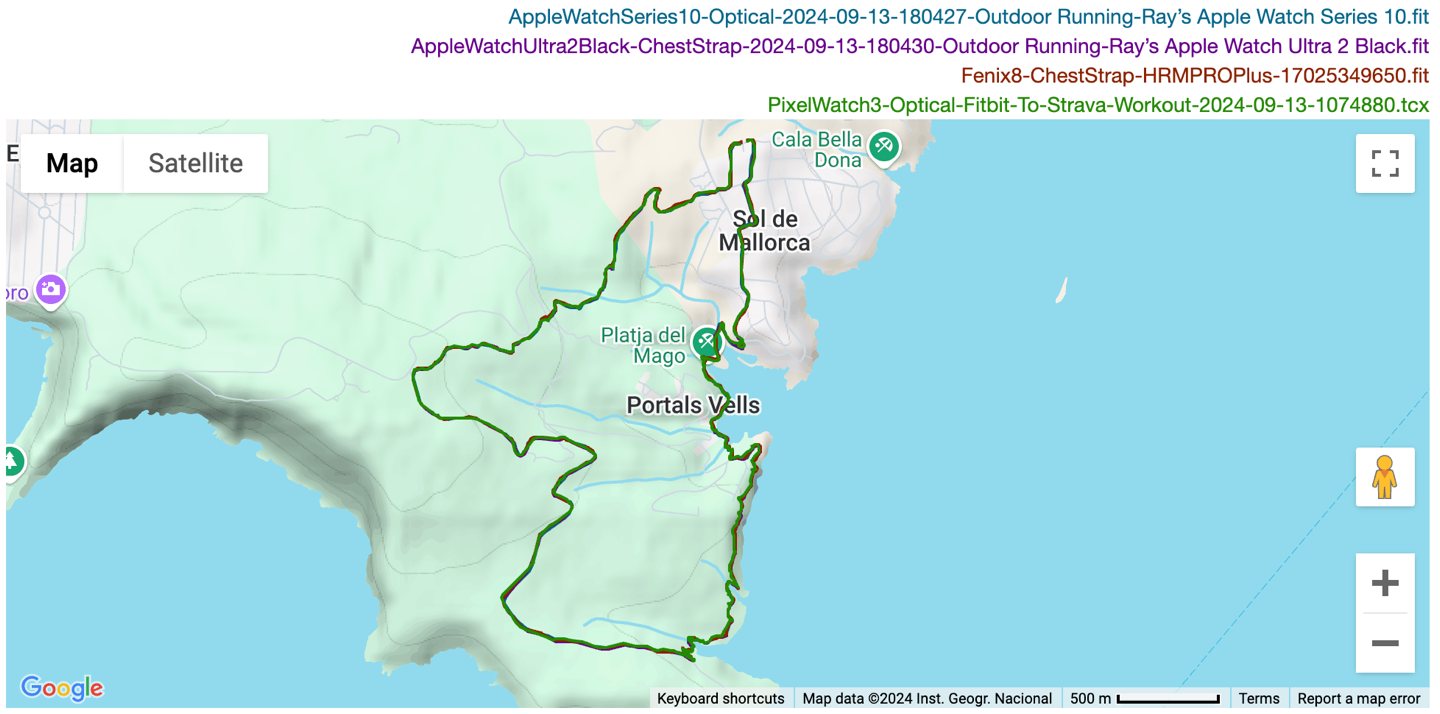
As we zoom in, we can see in the trees, all the units are very close:
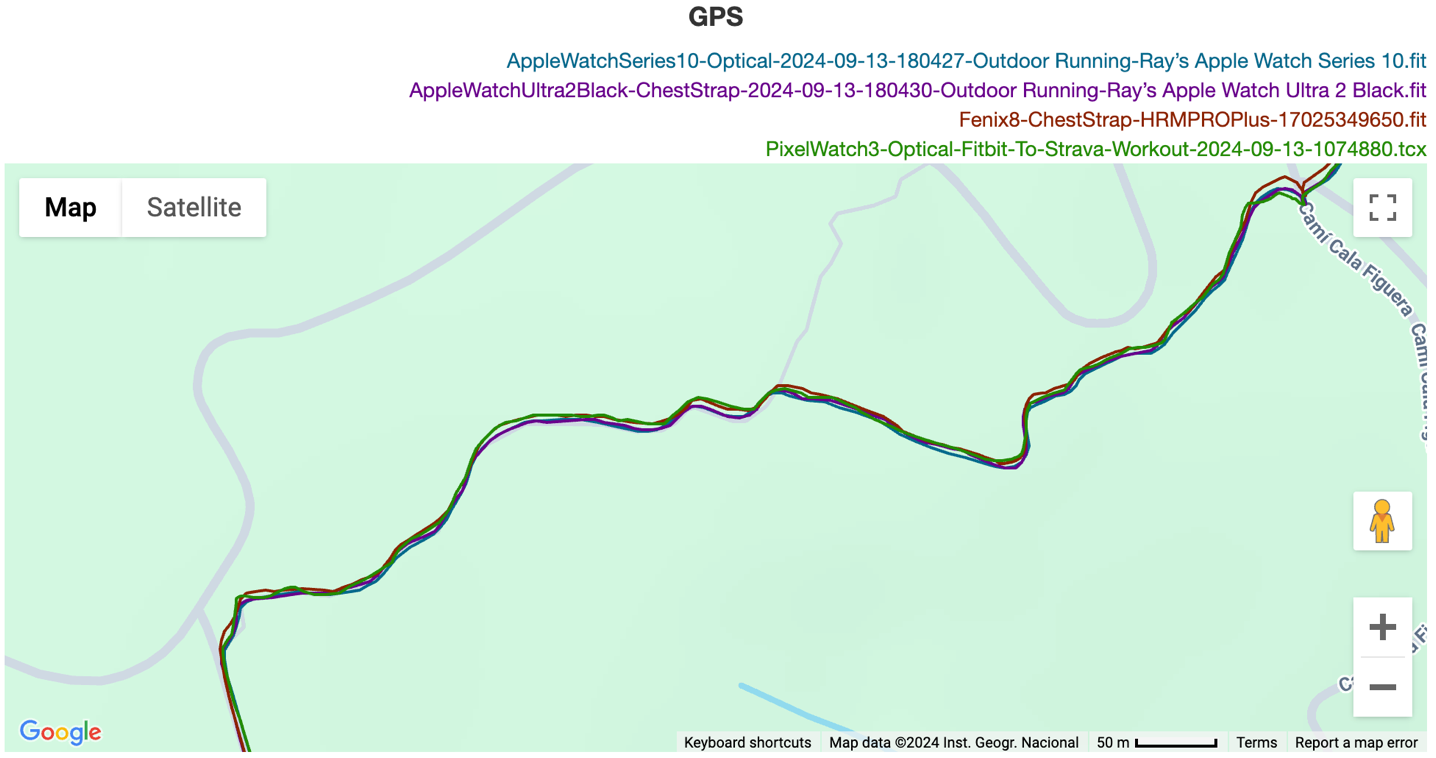
Yet, here’s another area where the Pixel Watch 3 GPS struggled in the woods, but the Apple Watch Series 10 nailed it. Neither of those units have multiband/dual-frequency GPS, and this shows that algorithms and antenna designs are more important than whether or not it has multiband GPS:
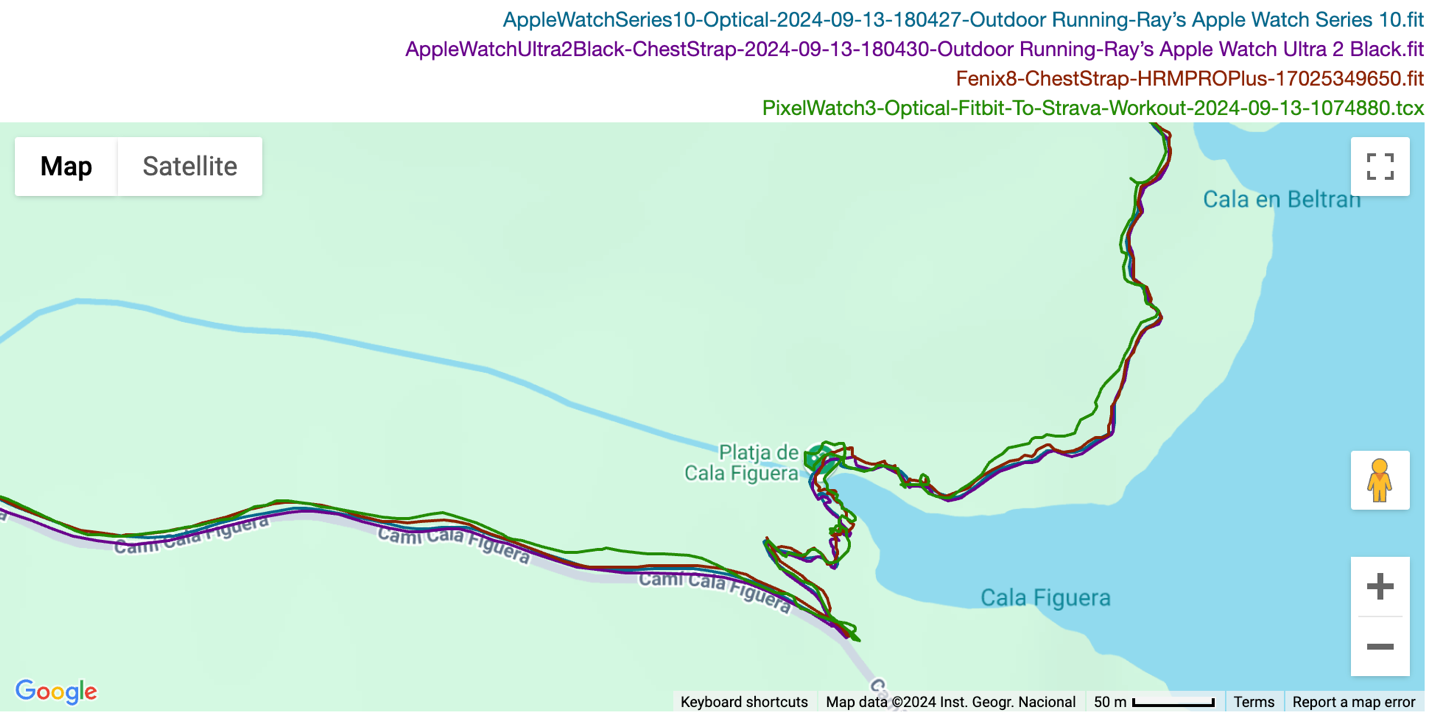
Looking at another run, this along a coastal route that included weaving through some high-rise hotels as well as eventually along cliffs and through trees, you can see at a high level, it’s virtually identical:
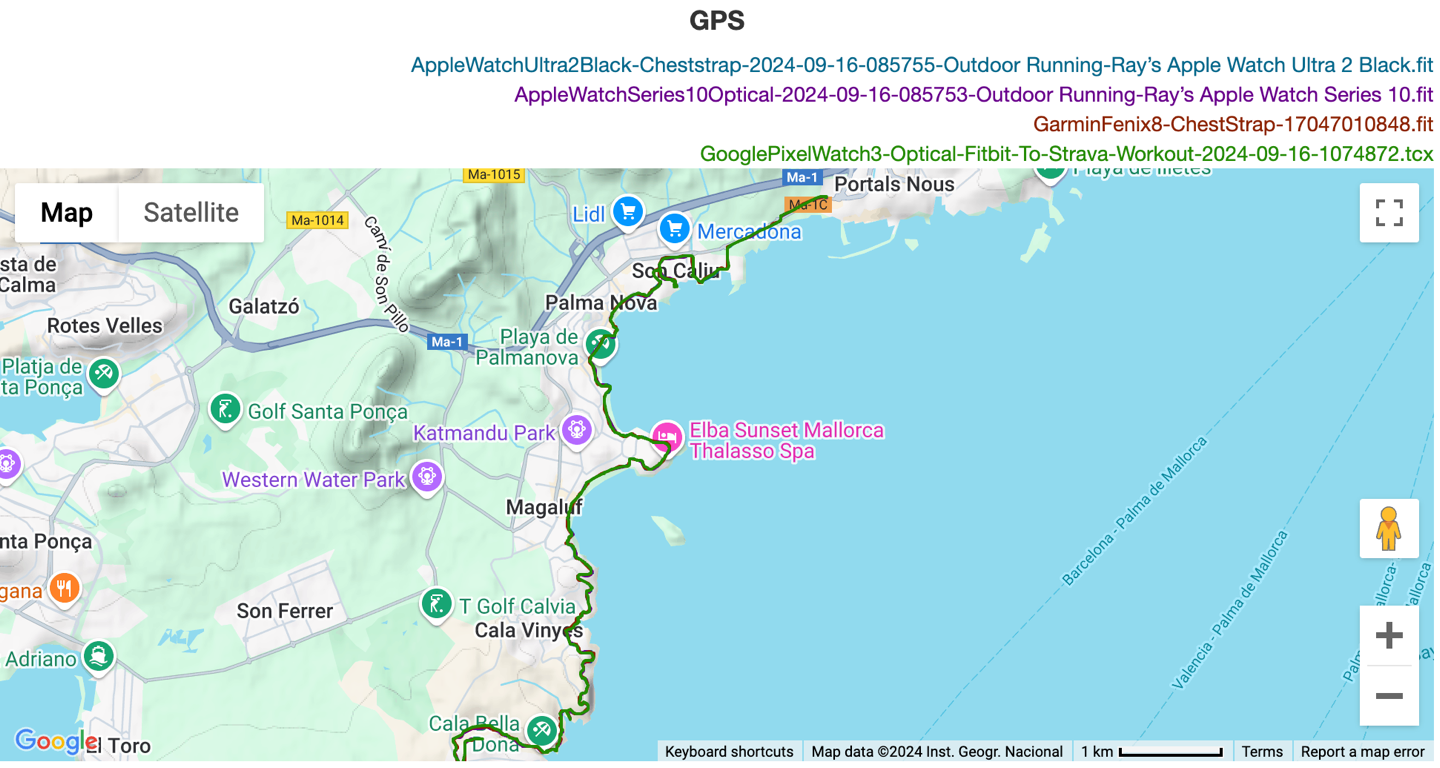
As I look at some of the areas near the high-rise buildings, again, I see no meaningful differences on the Apple Watch side:
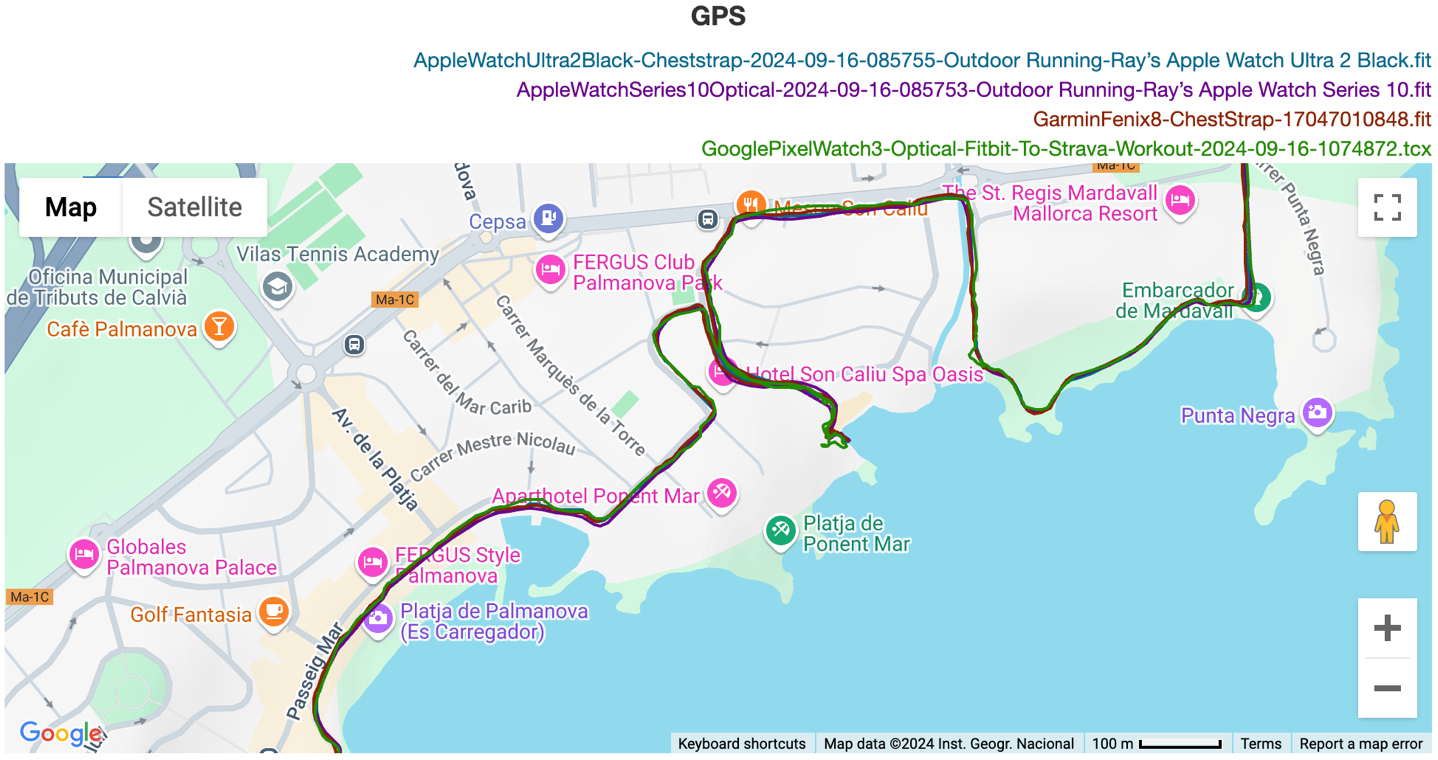
And the same is true along the coastal areas with some trees as well as steeper descents along cliffs:
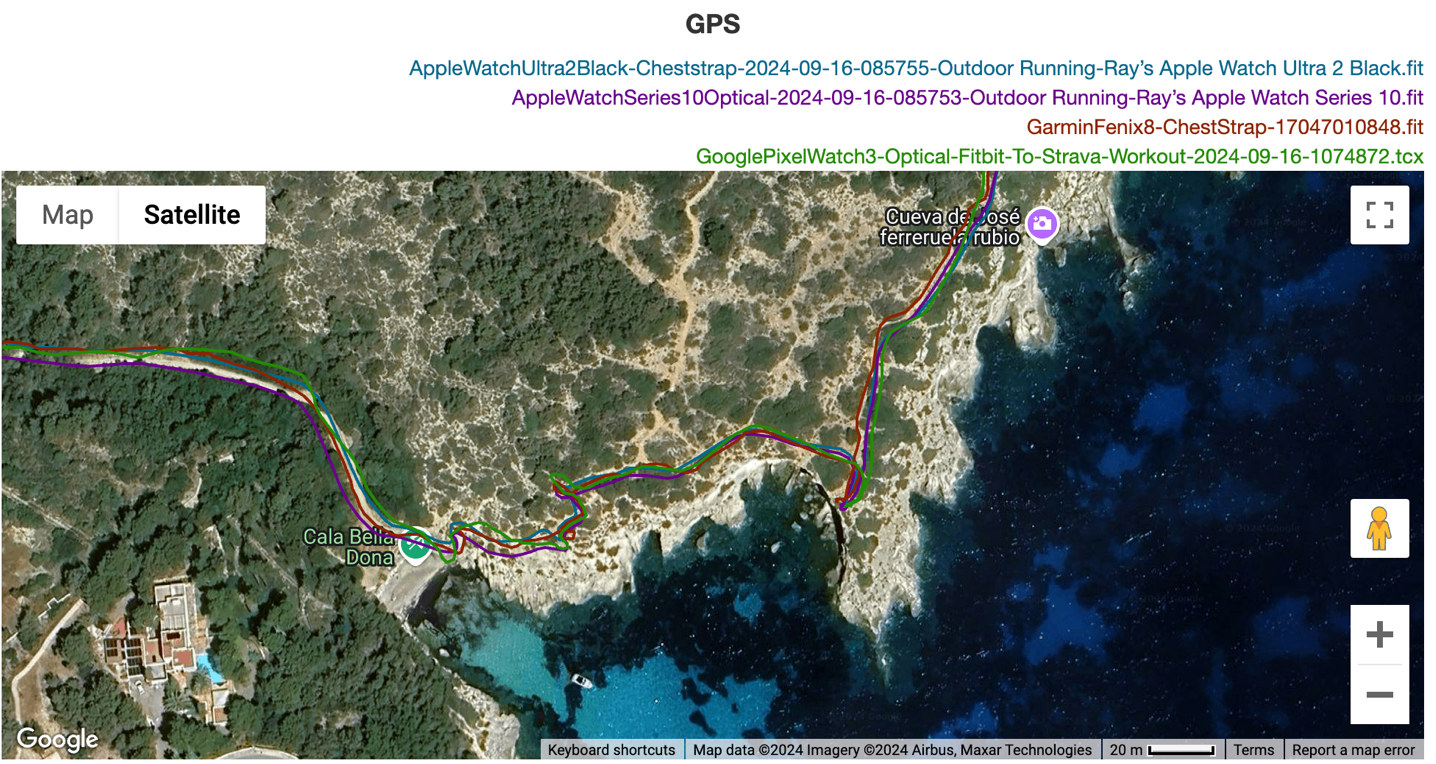
Ultimately, all of this matches all of my workouts with the Series 10 – there’s simply nothing of note in either heart rate or GPS performance to be of concern. It’s spot-on across the board. While one could argue that perhaps Apple might want to add dual-frequency/multiband GPS, I’m just not seeing a specific problem area that’s requiring that. I’ll be able to add/do some more deep city testing next week, though historically speaking Apple hasn’t really hugely struggled in that arena either with the Series 9. So I wouldn’t expect much difference here with the Series 10.
(Note: All of the charts in these accuracy portions were created using the DCR Analyzer tool. It allows you to compare power meters/trainers, heart rate, cadence, speed/pace, running power, GPS tracks, and plenty more. You can use it as well for your own gadget comparisons, more details here.)
Wrap-Up:
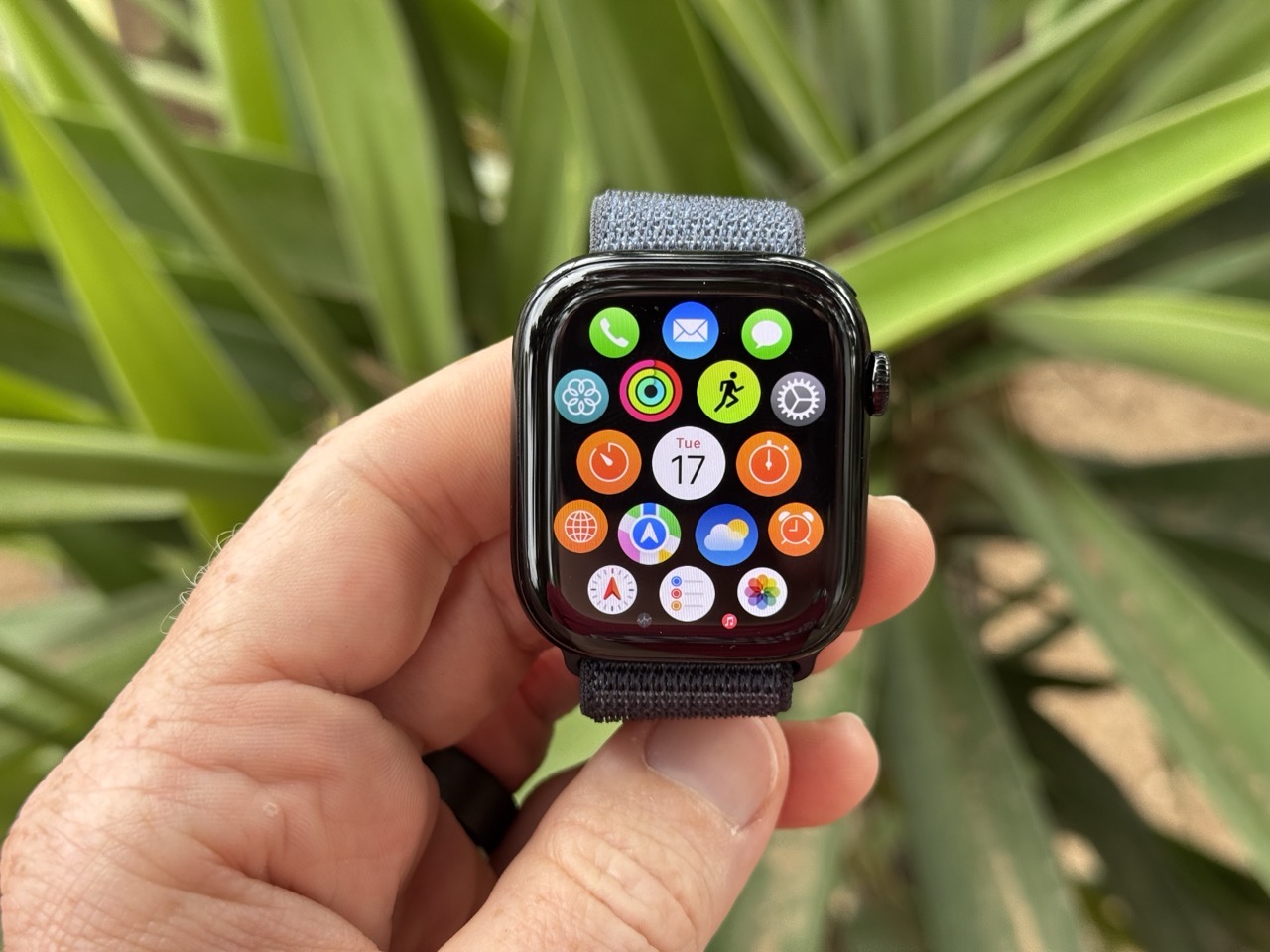
Ultimately, the Apple Watch Series 10 isn’t for existing Apple Watch Series 9 owners. It’s realistically for Series 7 and earlier owners. And it follows the normal Apple playbook of incremental hardware changes that make the upgrade more appealing after 2-3 years of ownership. All the while, Apple keeps on breaking the industry playbook of offering software updates to most watches made in the last 5 years or so. That helps the company keep it’s less frequent-upgrading customers happy, while concurrently offering techies an excuse to buy new things for all the latest bling.
The Series 10’s display is definitely bling, and it of course makes it kinda quirky that it’s bigger than the Ultra 2. That said, using the two side by side, you don’t really notice it in real-life (because of course, the Series 10 is only 3% bigger in active display area). Instead, the core difference you’ll notice is battery life (and, ‘Precision Start’ for workouts). But that’s a separate discussion for another day this week or so (the new Apple Watch Ultra 2 Black).
Many of the Apple Watch Series 10 features are really WatchOS 11 new features – and there are some good ones in there. The training load is off to a good start, and the offline maps and routing is equally off to a good start. I’d like to see both of those mature a bit more next year in WatchOS 12, but for now, they’ll likely meet the mainstream needs. But I think both native solutions also concurrently fall a bit short of the needs of an endurance sports athlete looking for quick routes from platforms like Strava or Komoot. Likewise, I’ll have to see how the depth gauge and snorkeling features mature over the coming weeks as Oceanic finishes their app. But as I noted above, the feature should still be a native feature, especially since Apple did all the hard work already.
Nonetheless, as we look at other core areas – the optical HR sensor and GPS performance is top-notch, as is general speed/usability of the watch. Plus of course the display as I noted earlier is great. If you were looking for a reason to upgrade an older Apple Watch, there’s plenty to choose from.
With that, thanks for reading!
FOUND THIS POST USEFUL? SUPPORT THE SITE!
Hopefully, you found this post useful. The website is really a labor of love, so please consider becoming a DC RAINMAKER Supporter. This gets you an ad-free experience, and access to our (mostly) bi-monthly behind-the-scenes video series of “Shed Talkin’”.
Support DCRainMaker – Shop on Amazon
Otherwise, perhaps consider using the below link if shopping on Amazon. As an Amazon Associate, I earn from qualifying purchases. It doesn’t cost you anything extra, but your purchases help support this website a lot. It could simply be buying toilet paper, or this pizza oven we use and love.

